In this article, I am going to share with you my SEO checklist and how you can complete it with step-by-step tutorials.
This SEO checklist actually works for small and even large size websites and it will boost your ranking, organic traffic, and SEO lead generation or sales depending on your business without focusing on things that will never make any difference.
And without further due, let’s get started:
Step #1: Set Up Basics
The first step in our SEO checklist is to set up the basics to help search engines to discover your website pages and find any issues on your website.
So let’s get started with the first and probably most important tool.
Google Search Console
The first tool you want to set up for your website is Google Search Console.
Google Search Console is a free tool provided by Google that helps you to monitor your performance in Google search engine results pages. It shows you:
- How many impressions your pages are getting.
- How many clicks they are getting.
- Your average CTR which you can also see for an individual page. (Read more about CTR Manipulation)
- Average ranking position in Google, again for each of your page and keywords.

- What keywords you are ranking for along with the same statistics.
- And so much more
Google Search Console is an essential tool for every webmaster and whenever you create a new website, installing Google Search Console will be probably your first step.
With that, setting up Google Search Console is not difficult at all, and here is a four-step process:
- Login or sign up into Google Search Console. I recommend you create a company Google Account for this, even if you are an individual because once your website is growing it is a hustle to move your property onto a different account.
- Once you are in, then click on add property in the left top corner.

- Then enter your domain here. I recommend you to verify your domain in both “Domain” and “URL prefix” because some tools prefer URL prefix and some “Domain” verification.
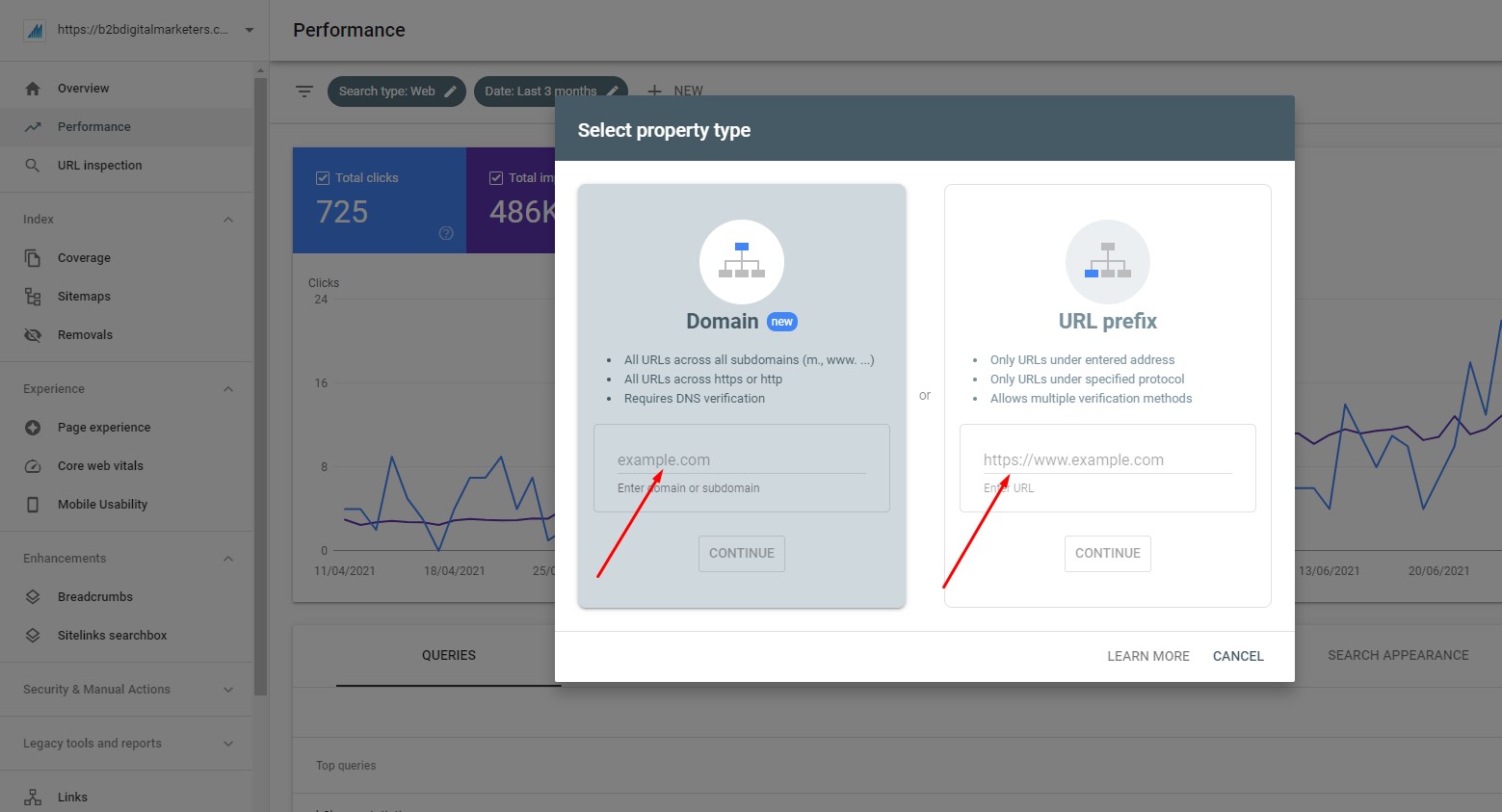
- After you need to verify your domain. This is when most beginners struggle. However, the easiest way is to ask your hosting for help. For example, SiteGround provides excellent support and help even with verifying your domain. Also, you can watch some YouTube videos on how to verify your domain.
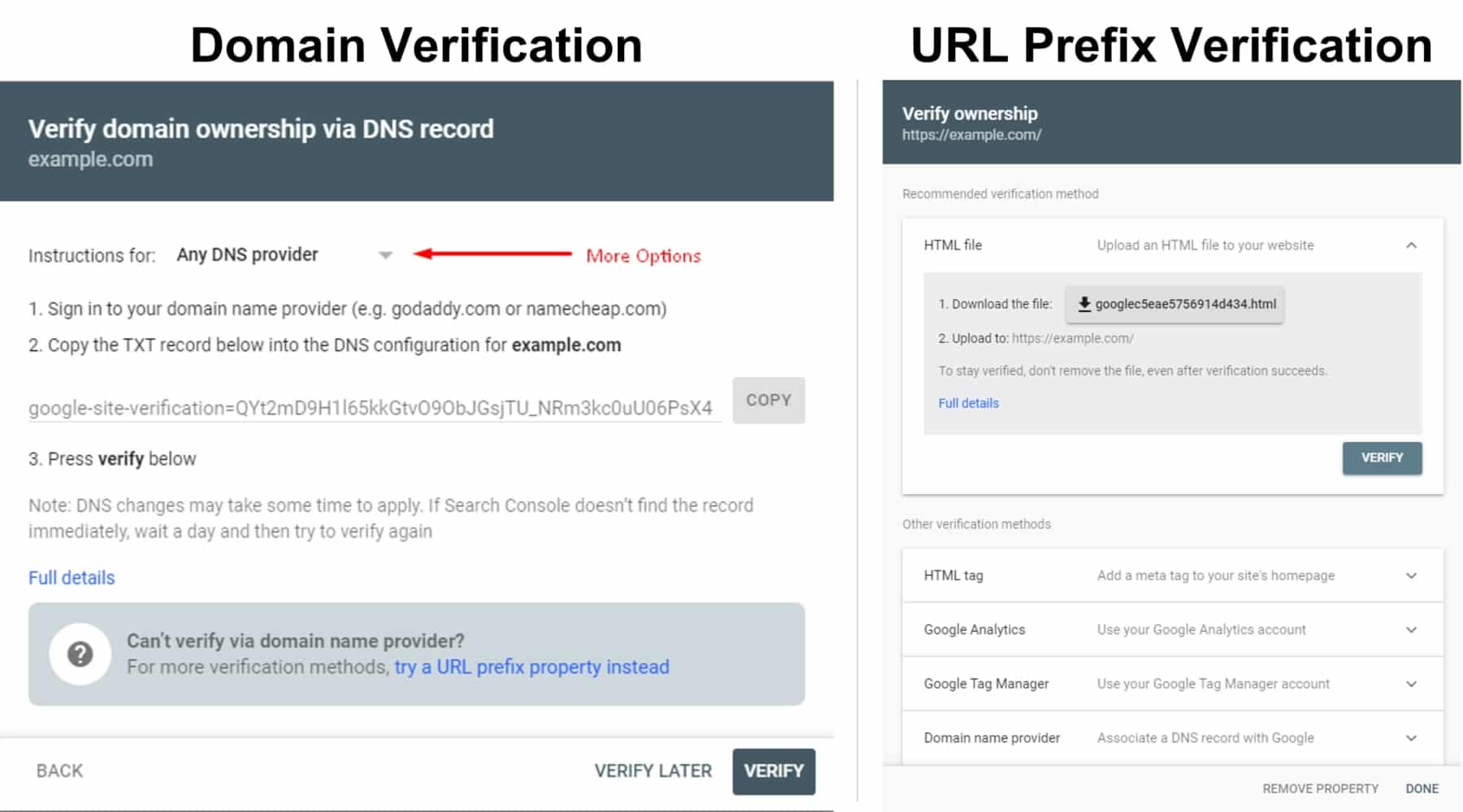
Once you complete installing Google Search Console, then wait a few days and you will start seeing your impressions, clicks, and other metrics.
Google Analytics
The second essential tool you should set up for your website is Google Analytics.
Google Analytics is a free web analytics tool provided by Google that gives you important information about your website traffic such as the source, average time spent on the website, generated revenue, and so much more.
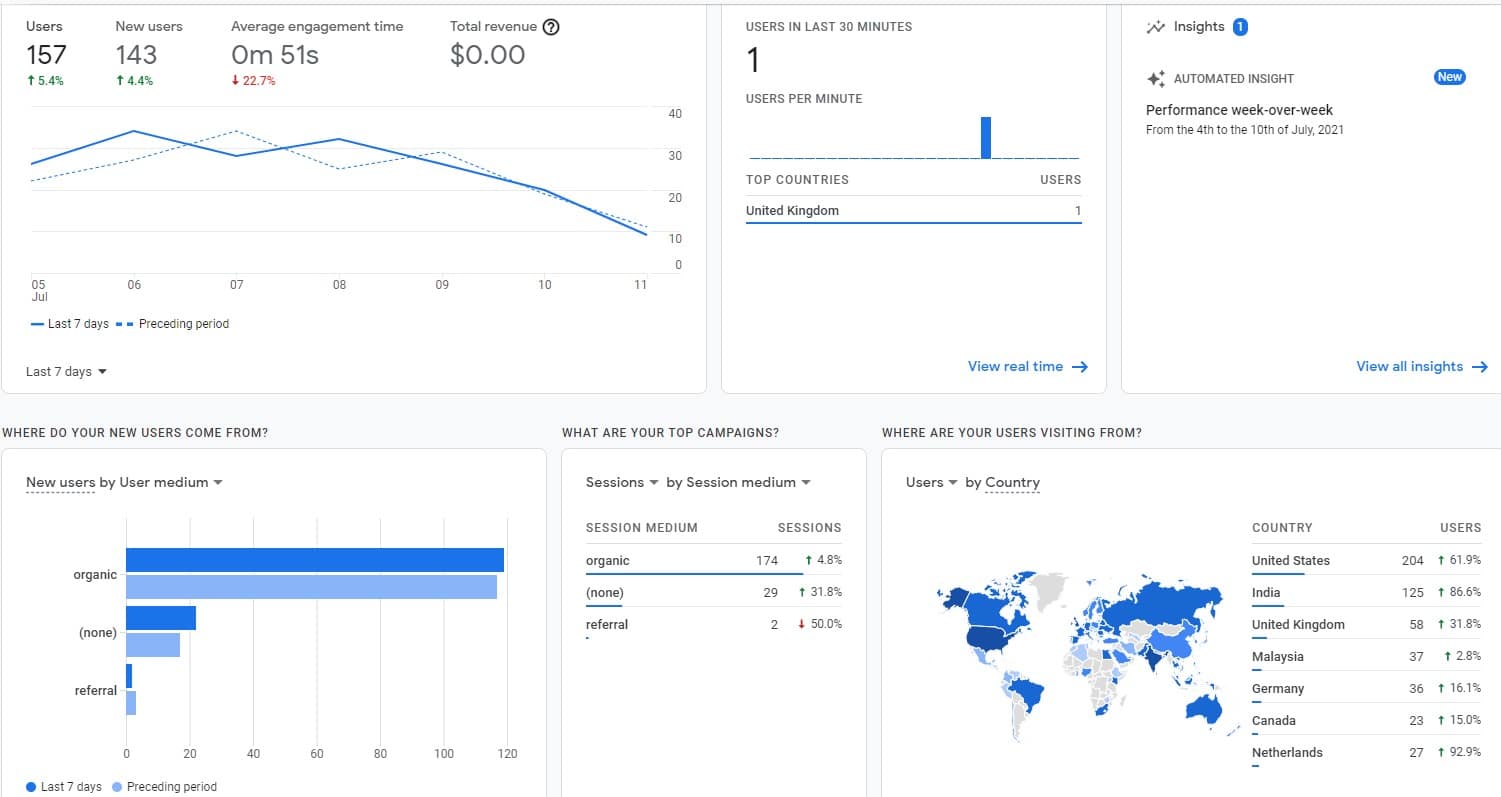
And while Google is trying to make Google Analytics as intuitive and user-friendly as possible the truth is that it hides so many features, settings, and customization that even advanced marketers still have problems using it to its fullest.
However, regardless of the complexity, even absolute beginners should set up Google analytics and track their website traffic because it gives you a view to effectively run your marketing campaign and track your digital marketing effectiveness.
Anyway, installing Google Analytics is not hard as well and same like with Google Search Console you will need to install it on your website.
Again, there are different ways how to do that, so I won’t delve further into it as you can watch YouTube tutorials depending on the way you choose to install Google Analytics.
Also, installing Google Analytics depends on the CMS system and the theme you are using so I will not show you how to install it on your website.
However, I do recommend you to check out Google Analytics Academy because it will help you to maximize the use of Google Analytics and get the most out of your website data.

Bing Webmaster Tools + Microsoft Clarity
Another useful tool you should install is Microsoft Bing Webmaster Tools and Microsoft Clarity.
Similarly, like Google Analytics and Google Search Console, Bing Webmaster tools is free analytics tool from Microsoft which allows you to add your website and get personalized information about your website and traffic.
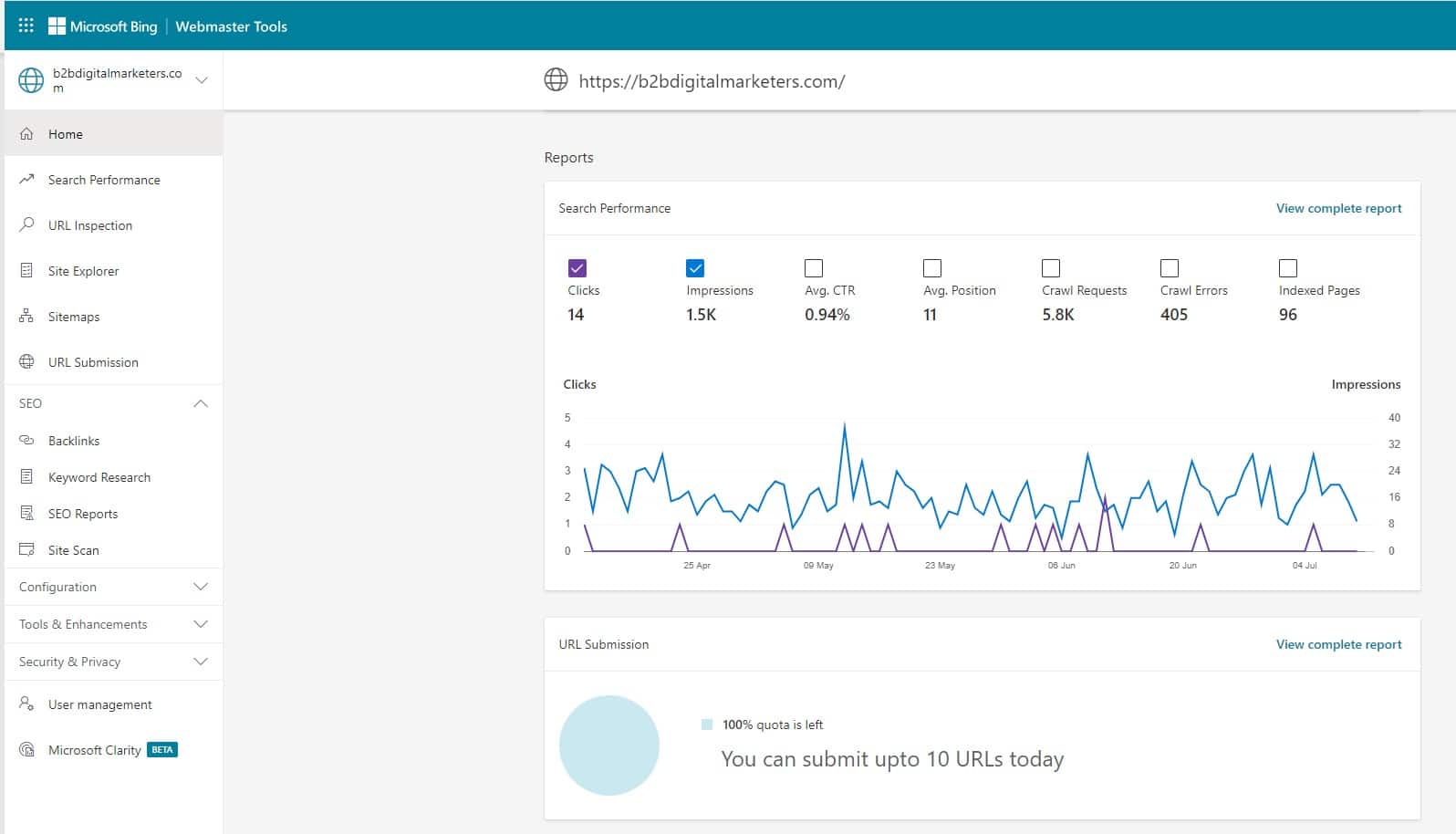
However, Bing Webmaster Tools also comes with a few handy tools that you should check out.
The first tool is their Site scan which is a free tool to help you scan your website and display any errors on your website.
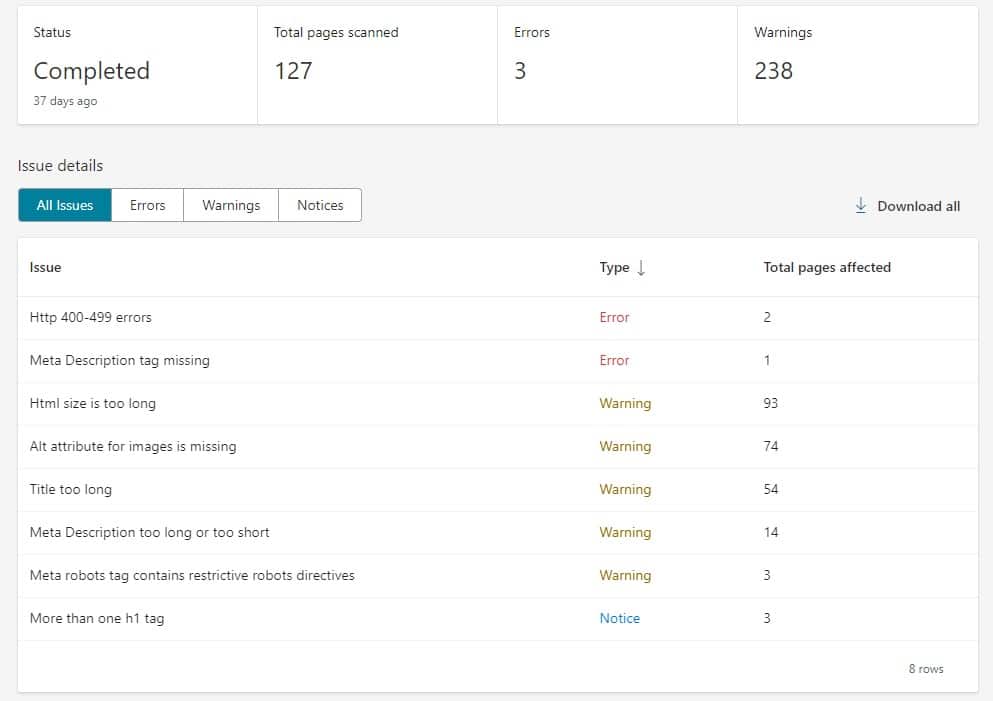
And the second tool that you should definitely check out is Microsoft Clarity which comes with Bing Webmaster Tools.
Microsoft Clarity is a free user behavior analytics tool that helps you understand how users are interacting with your website through session replays and heatmaps.
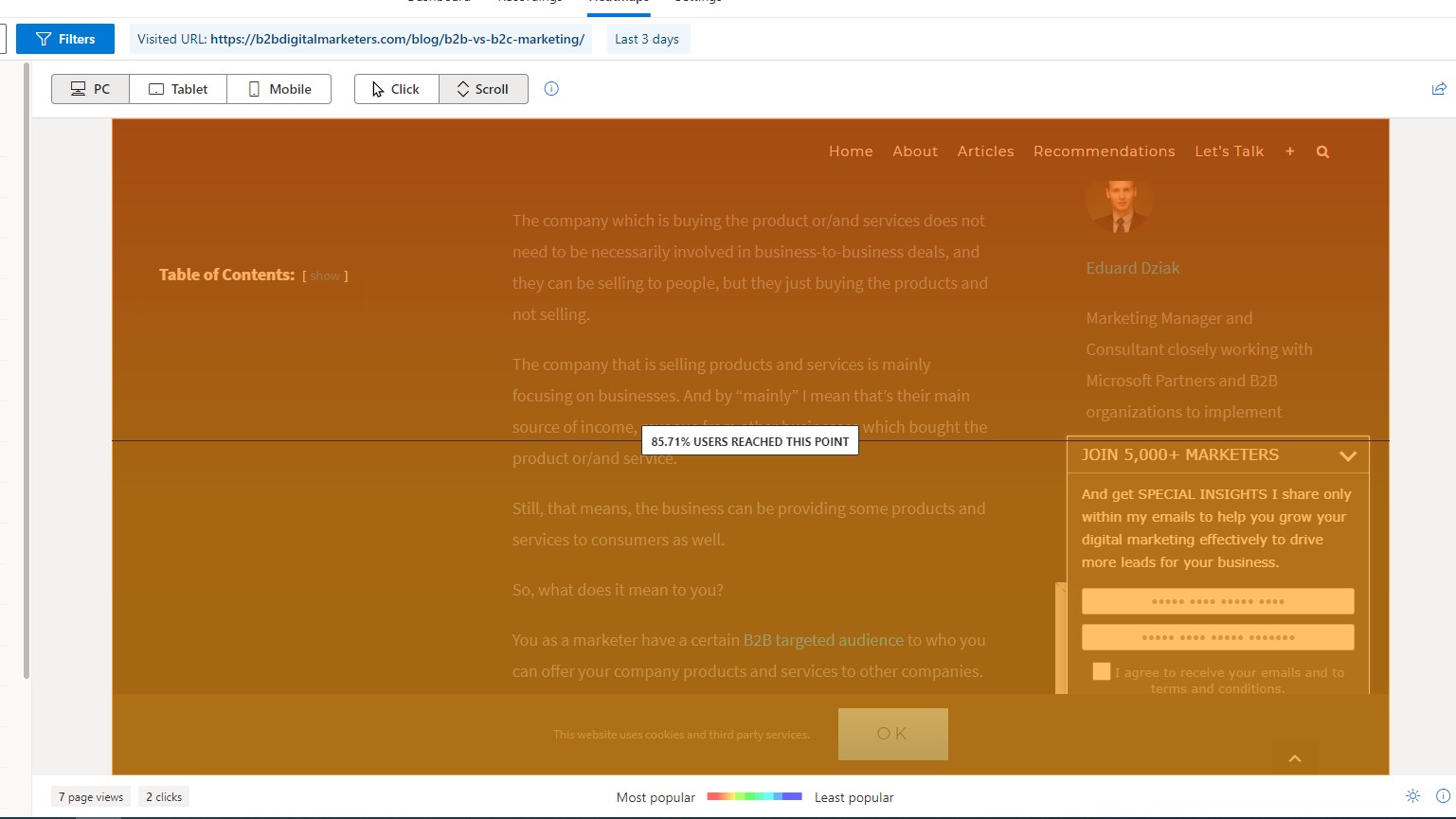
The tool records your visitors which gives you over the shoulder view of each of your visitor and what they are doing on your website.

Another great thing about Microsoft Clarity is that they give you a detailed dashboard where you can get insights about your traffic such as sessions with dead clicks which is super important, rage clicks, scroll depth and so much more.
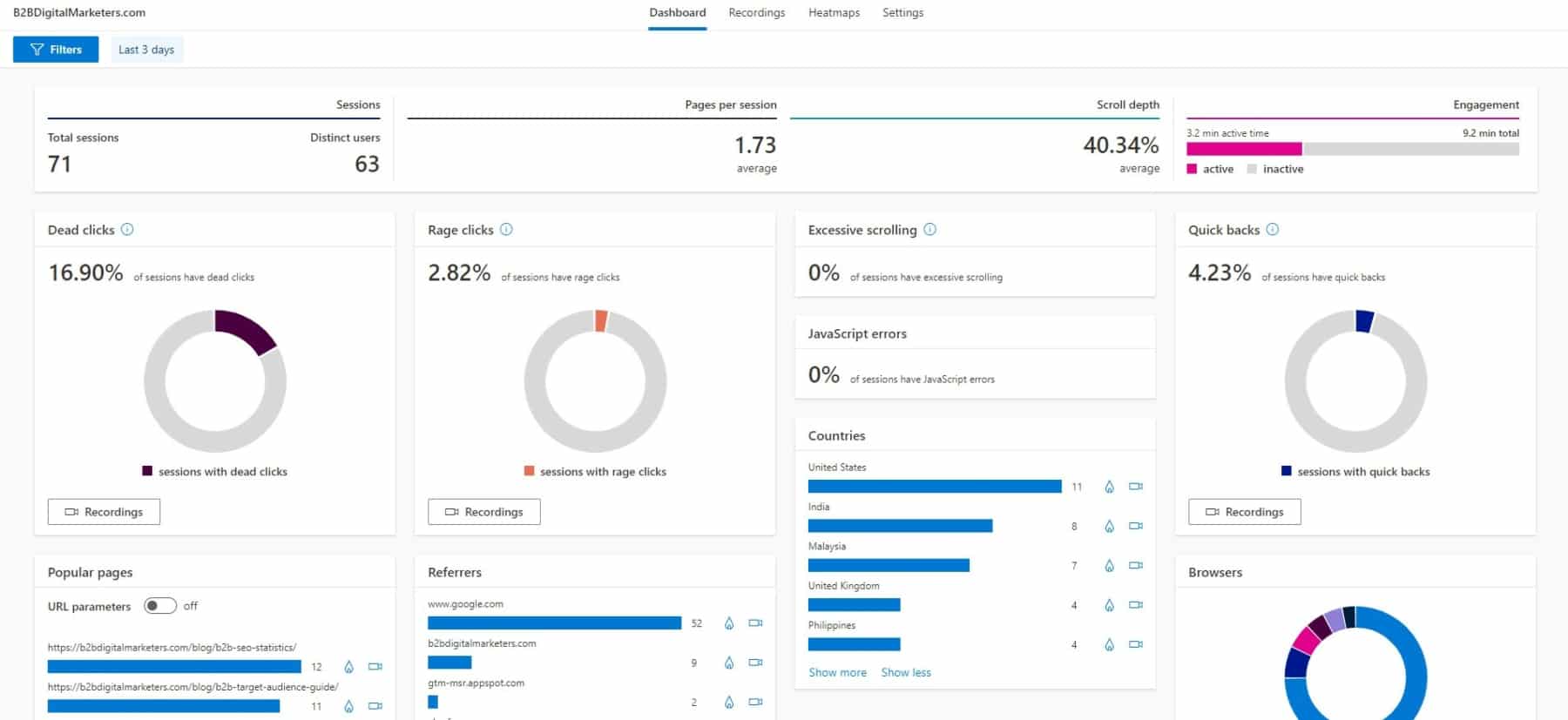
Therefore, Microsoft Webmaster Tools and Microsoft Clarity are super important tools you should set up for every of your website. These tools are absolutely for free and tools like Microsoft Clarity often cost tens and even hundreds of dollars.

SEO Plugin
Another tool you should set up is an SEO plugin.
SEO plugins are extension modules for content management systems, browser, and software solutions that extend the capabilities of your solution in order to help you tackle some of the SEO challenges such as implementing schema markup, title tags and meta description, keyword density, and more.
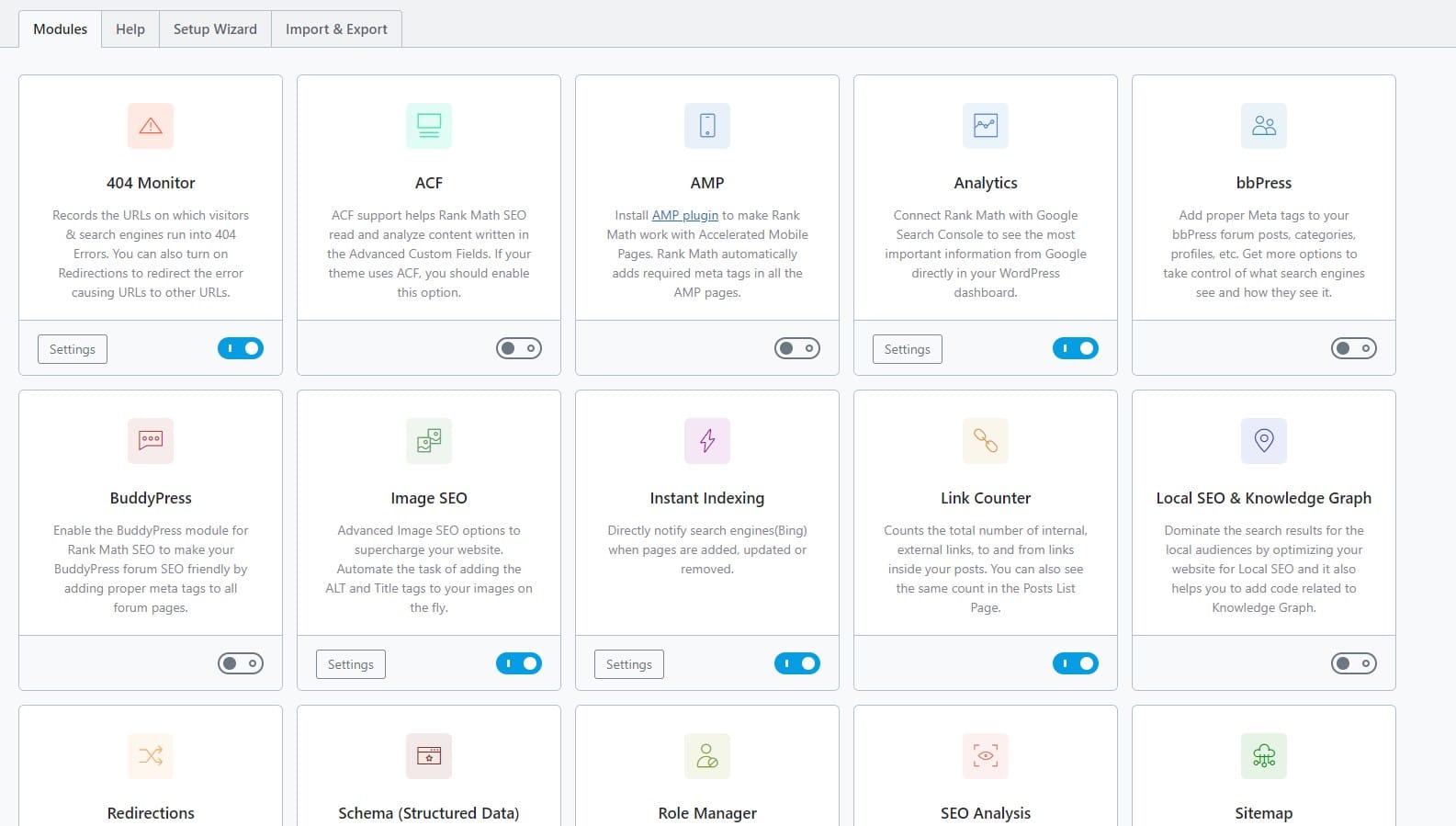
(Dashboard of my preferred SEO Plugin Rank Math. Recommending getting PRO version to boost your traffic)
Using SEO plugin is beneficial to SEO rookies and even pros as it provides you with important tools and simplifies some of the tedious tasks such as creating sitemap or setting up redirects and others.
SEO plugins work on a page level as well and provide you with the best on-page SEO practices that you should apply in order to improve your ranking for the page.
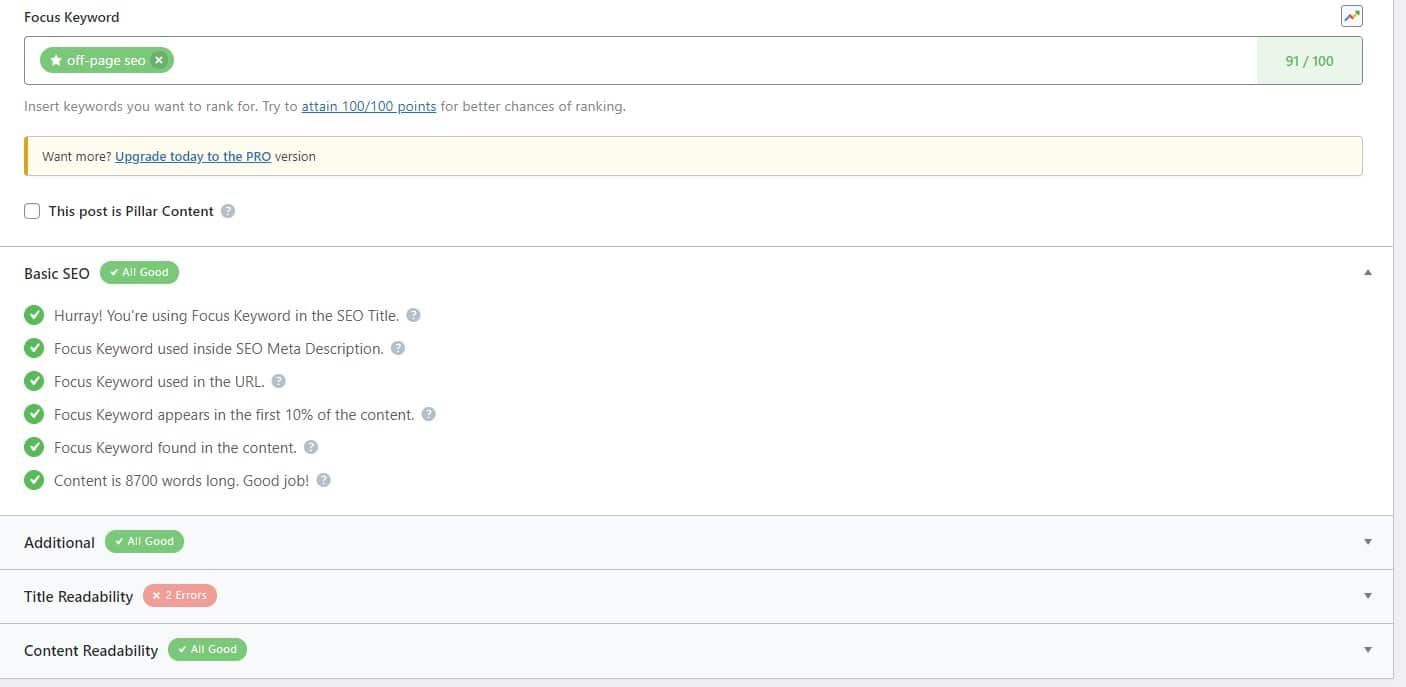
With that, there are many different SEO plugins you can use for your website and each of them has its pros & cons. However, my recommended SEO plugin is Rank Math for WordPress.

So if you are using WordPress that I recommend you to give it a shot.
SEO Tool
And the last setup I recommend you to have on your website is for SEO Tool.
Similarly, like the SEO plugin, SEO tools help you to improve your SEO results by giving you important information about your website, keywords, competitors, and backlinks.
For example, SEO tools scan your website and give you detailed health reports about all the errors, warnings, and notices such as slow page loading speed, broken pages, silo pages, alt text missing and so much more on your website.

SEO Tools also gives you essential information about your targeted keywords along with keyword ideas that you should be targeting to attract more of your target audience.

Then it allows you to spy and scan your competitors to see what is their approximate traffic, where the traffic comes from, their organic keywords report and SERP Features, and much more.
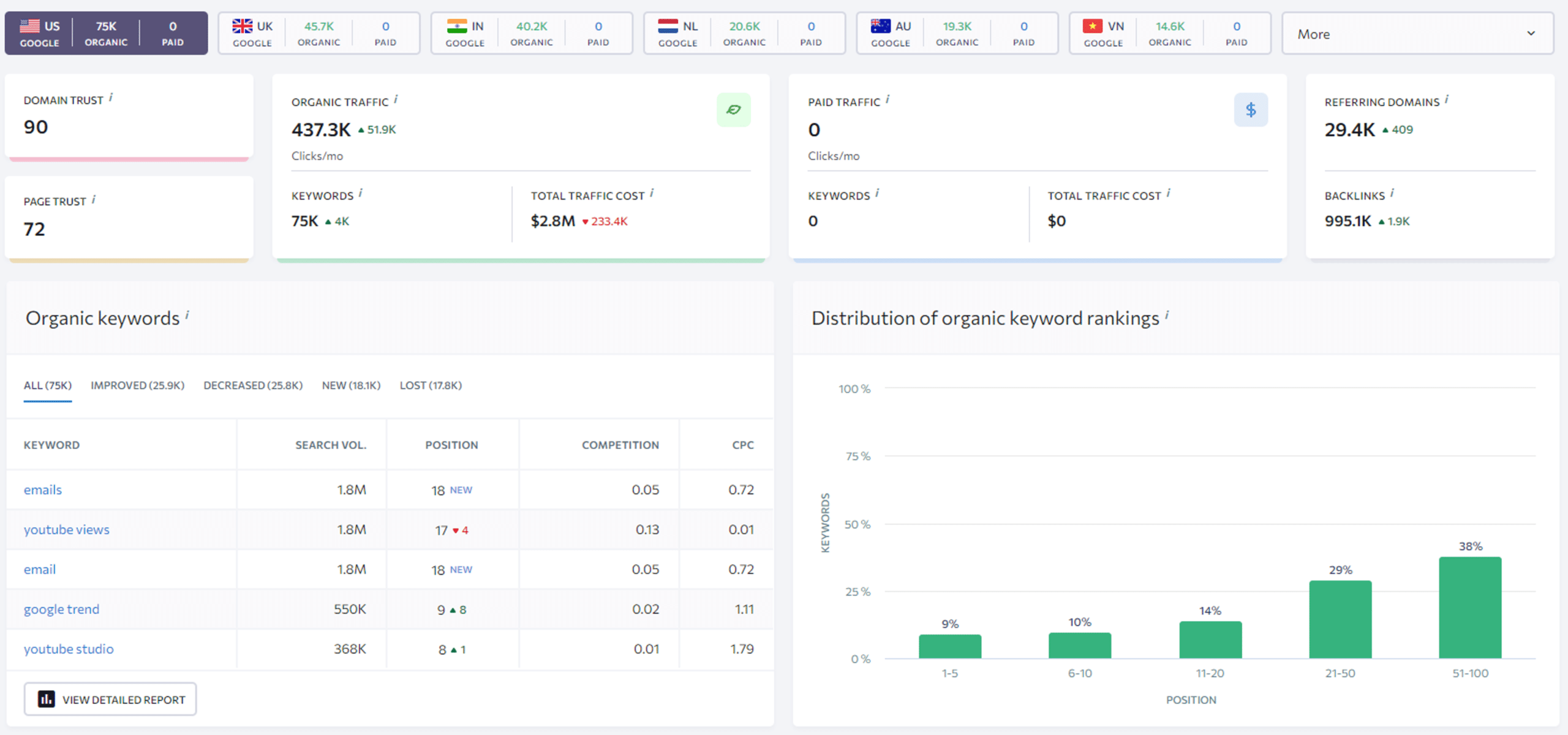
And lastly, I want to show you, you can analyze your competitors backlink profiles and see where they are getting backlinks and find link-building opportunities. This is super important when you are doing link building.

And this is just a fraction of what you can do with an SEO tool. However, all this information are essential for you to grow your SEO and website and if you look at any high ranking competitor in your niche, they are probably using SEO tool on a daily basis.
Of course, there are many different SEO tools you can use for your website and each of them has its own benefits. But if you are just starting, then I recommend you to try SE Ranking.
SE Ranking is an all-in-one SEO software with over 30 tools for every task in search marketing. The platform provides analytical data and monitoring features that help specialists, agencies, marketers, and business owners bring their websites to the top of the SERPs and stay there.

And compared to other SEO tools SE Ranking offers by far the best value for money which makes it available for specialists and companies with limited marketing budgets starting from as little as US$25 per month.
I have been using SE Ranking actively for the last 4 months and I 10x my search visibility and organic traffic.

Step #2: Crawling & User Experience
Once you finish setting up the basics the next step of your SEO checklist is to ensure your website is crawlable by search engines and it provides a unified user experience.
So let’s first start with factors that help search engines to crawl your website.
Sitemap
The first thing you should definitely have on your website is the sitemap.
A sitemap is a file where you provide information about your pages, videos, and other files on your website and the relationship between them. Search engines like Google then read the file to crawl your site efficiently and effectively.
A sitemap also tells search engines which pages are important to you. Thus, you might improve the ranking for the most important pages on your website.
With that, to build and submit your sitemap, first, you must decide what type of sitemap you want to use. There are four types of sitemap:
- XML Sitemap: This is the most common and used type of sitemap. Here you will have a list of all your pages including blogs, categories, products, services, and other pages. Most likely you will need to use this one.
- Video Sitemap: This is specifically used to tell Google about your video content on your website and it is an extension to your classic sitemap.
- Image Sitemap: This is again used to tell Google about your pictures on your website and it works as an extension. For example, if you are like me and having tens of pictures on your blog, then I recommend you to have it.
- News Sitemap: This helps Google to find fresh content on your website that is approved for Google news.
Again, as I said, video and image sitemaps are only extensions to your original XML sitemap and you should decide if you need them. However, if you are publishing blog posts I do recommend you to have an image sitemap.
Create Sitemap
Creating your sitemap is not hard at all if you are using CMS systems like WordPress, Drupal, Joomla, or HubSpot CMS. All these provide a sitemap for you.
For example, if you are running your website on WordPress like 60% of us do, then an SEO plugin like Rank Math will help you to set up and install a sitemap for you.
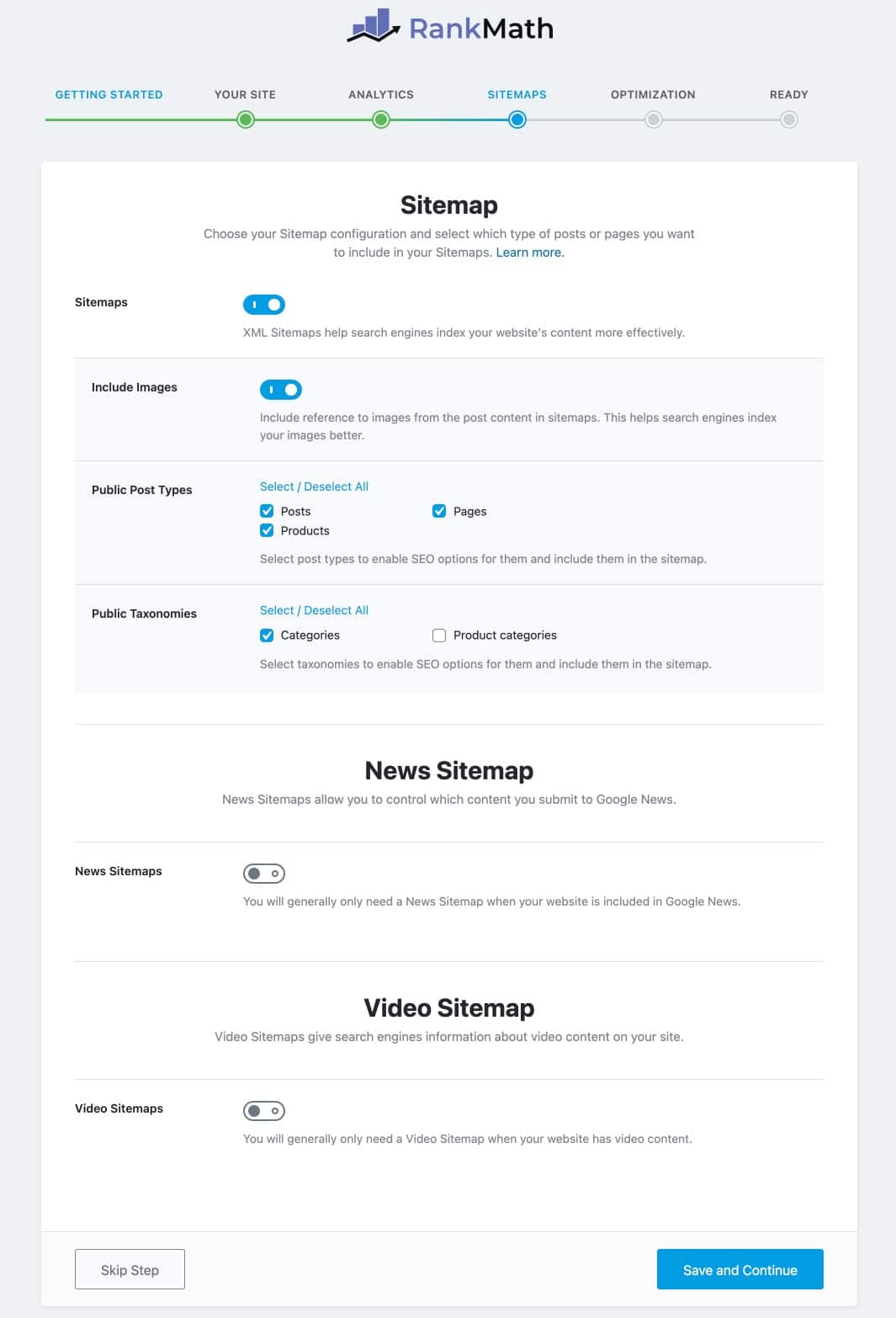
Otherwise, you can also use third-party tools to generate sitemaps for yourself. For example, in SE Ranking you can quickly generate your XML sitemap using their website audit feature. Then just upload it to your website and you are good to go.
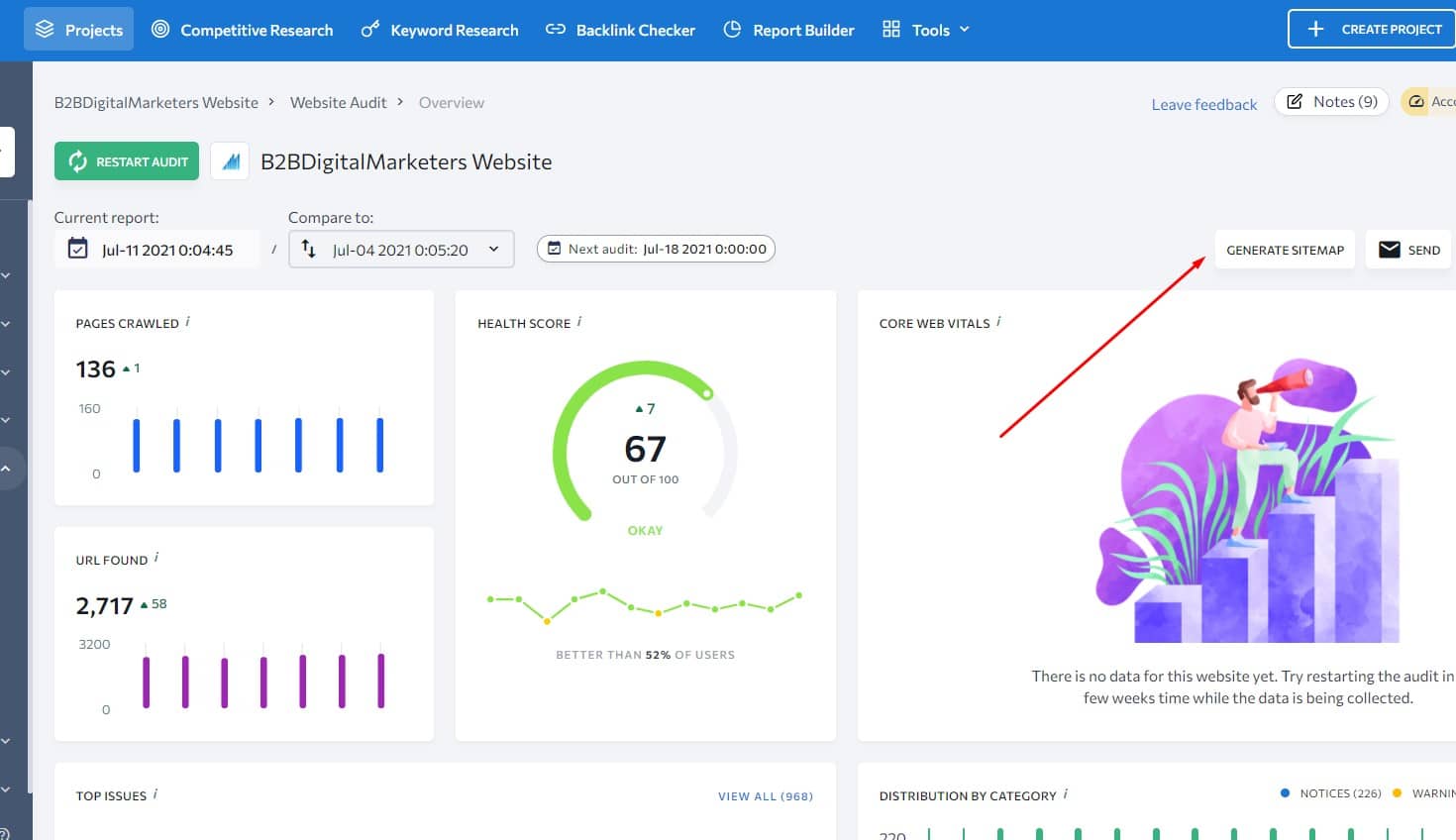
Submit Your Sitemap
Once you have built your sitemap, then you just need to submit it to search engines.
To submit it you need to have the URL of your sitemap. If you are using Rank Math or another SEO plugin, typically they give you the URL in the settings just like this.
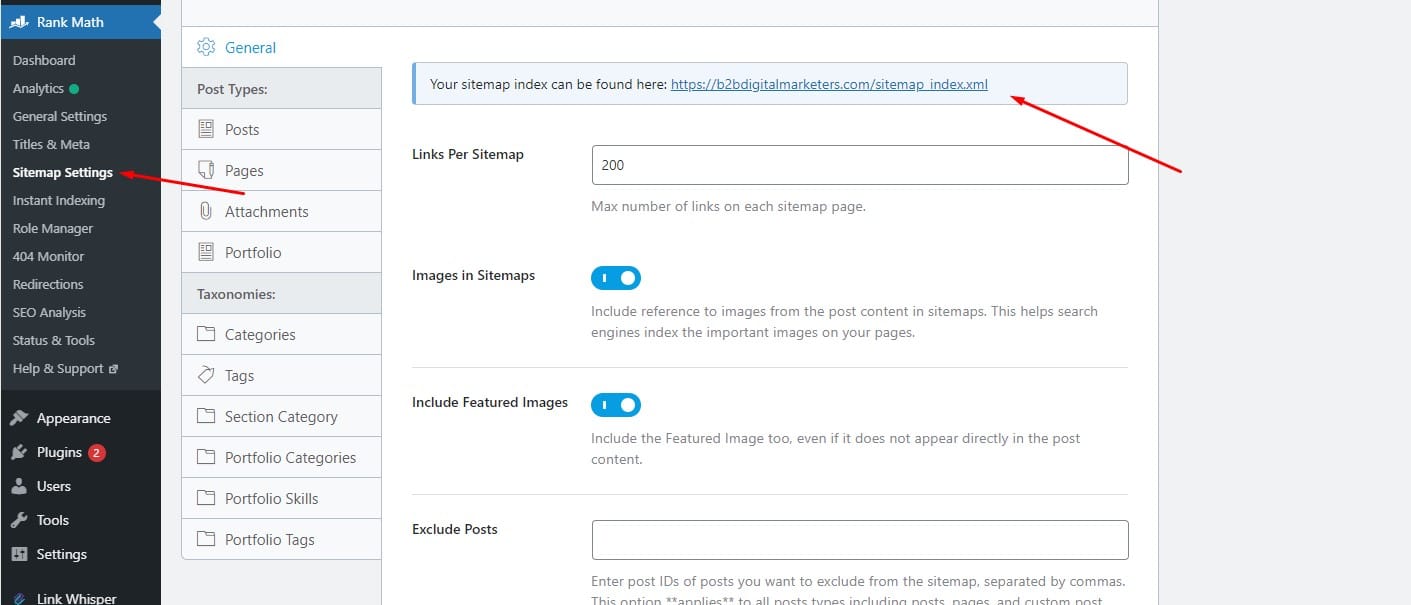
I also recommend you open the sitemap index file (just enter the sitemap URL into your browser) and submit the rest sitemaps within.

If you have used other tools to generate a sitemap, then you must know the location where you have submitted your sitemap and the exact name of the file.
Alright, once you have the URL, then open Google Search Console and Bing Webmaster Tools to submit your sitemap.
In Google Search Console, open the “Sitemaps” feature under Index and submit your sitemap index and other containing sitemaps.
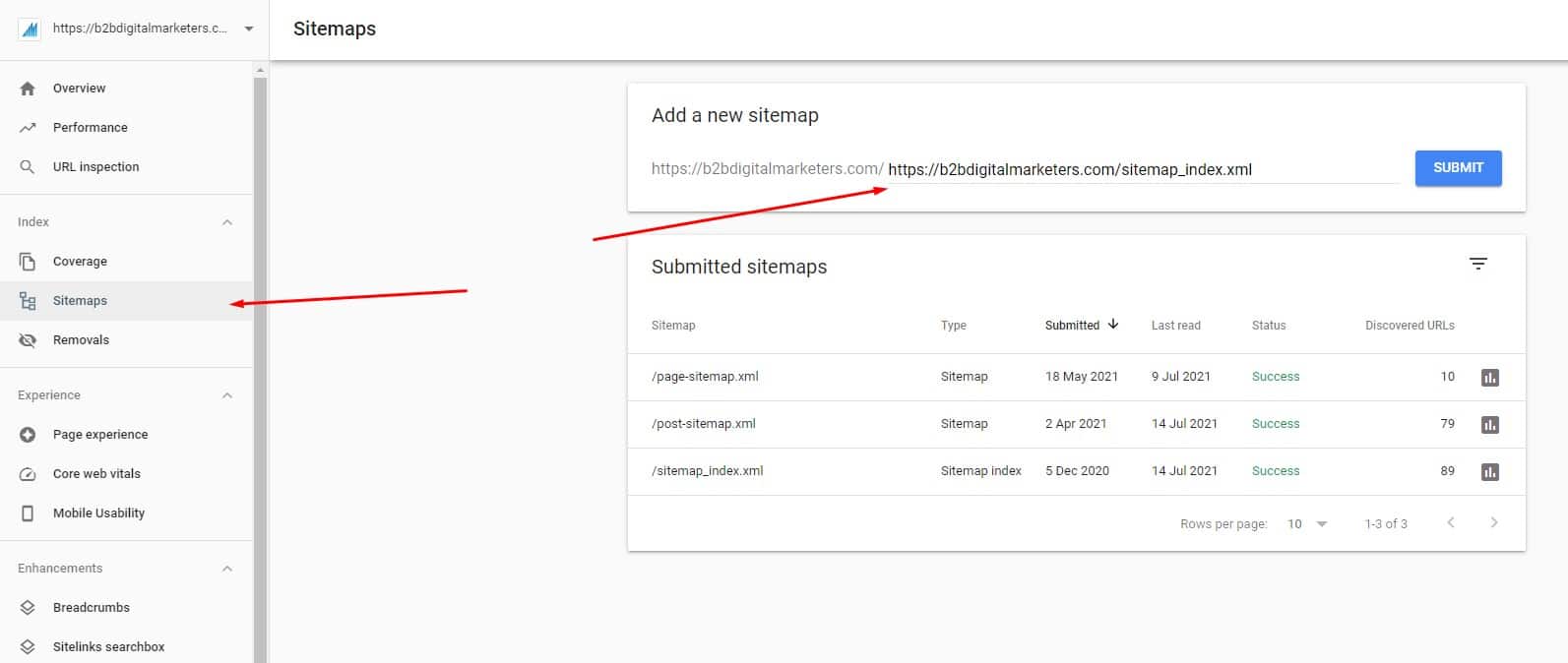
And in Bing Webmaster tools open as well the “Sitemaps” feature and click on “Submit sitemap” and submit all your sitemaps.
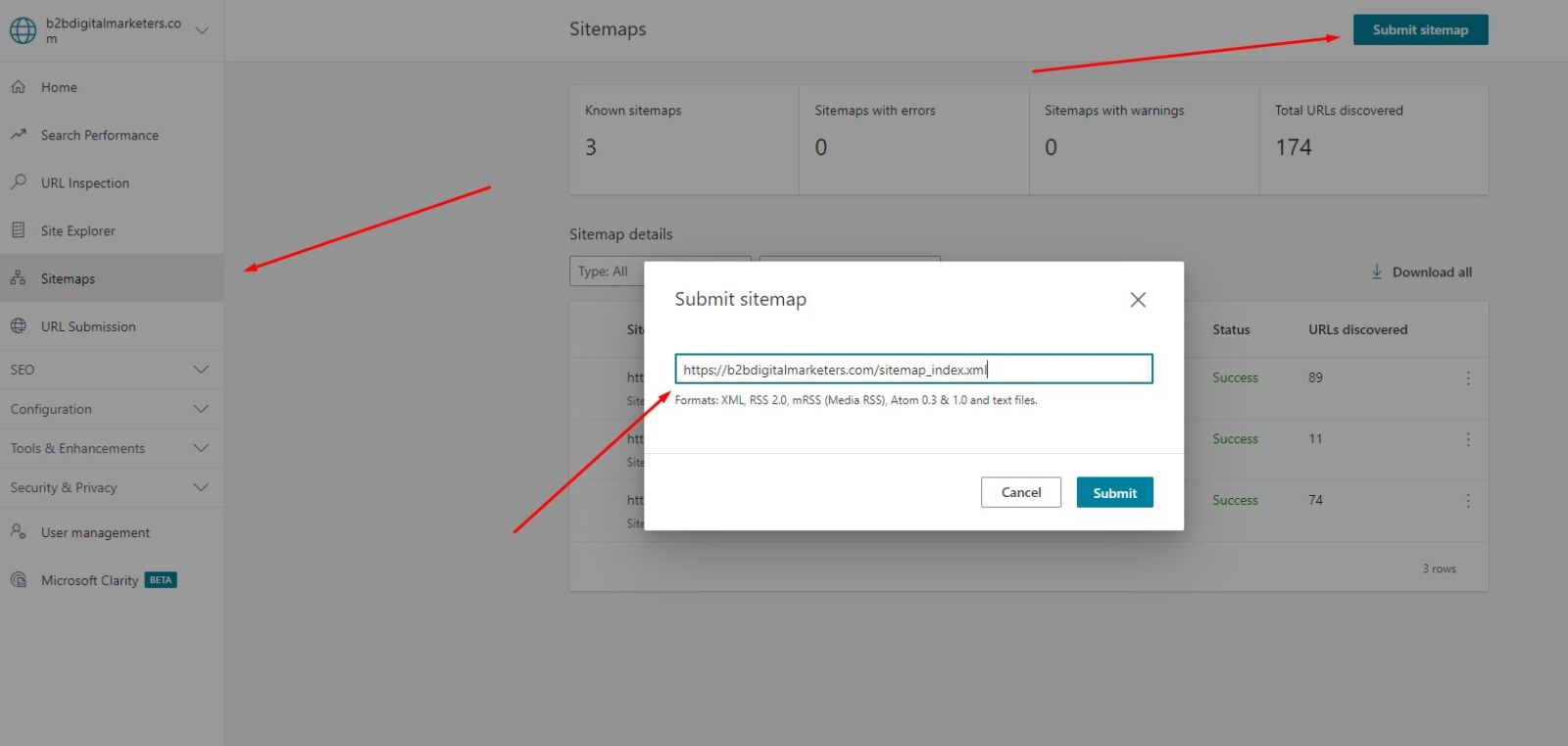
And there you are done with the sitemap.
Robot.txt
The next important file you need to have on your website is Robot.txt
Robot.txt file tells search engines like Google what pages you want them to access and crawl and what pages you want to keep out of the index. Such pages could be private pages only for members or protected pages only for stakeholders.
And to create your robot.txt, typically CMS systems like WordPress will create it for you and then SEO plugins will help you to control what pages you want and don’t want to index without any need for coding.

However, if your system does not create a robot.txt file for you, then you can check out Google guide on robot.txt and how to create it where they walk you through the process and the best practices.
Site Architecture for SEO
Another very important aspect to help search engines crawl and better understand your website is site architecture.
Site architecture or site silos refers to the structure of how your website content is organized. This structure helps search engines to understand what your content is about and the relationship between pages.
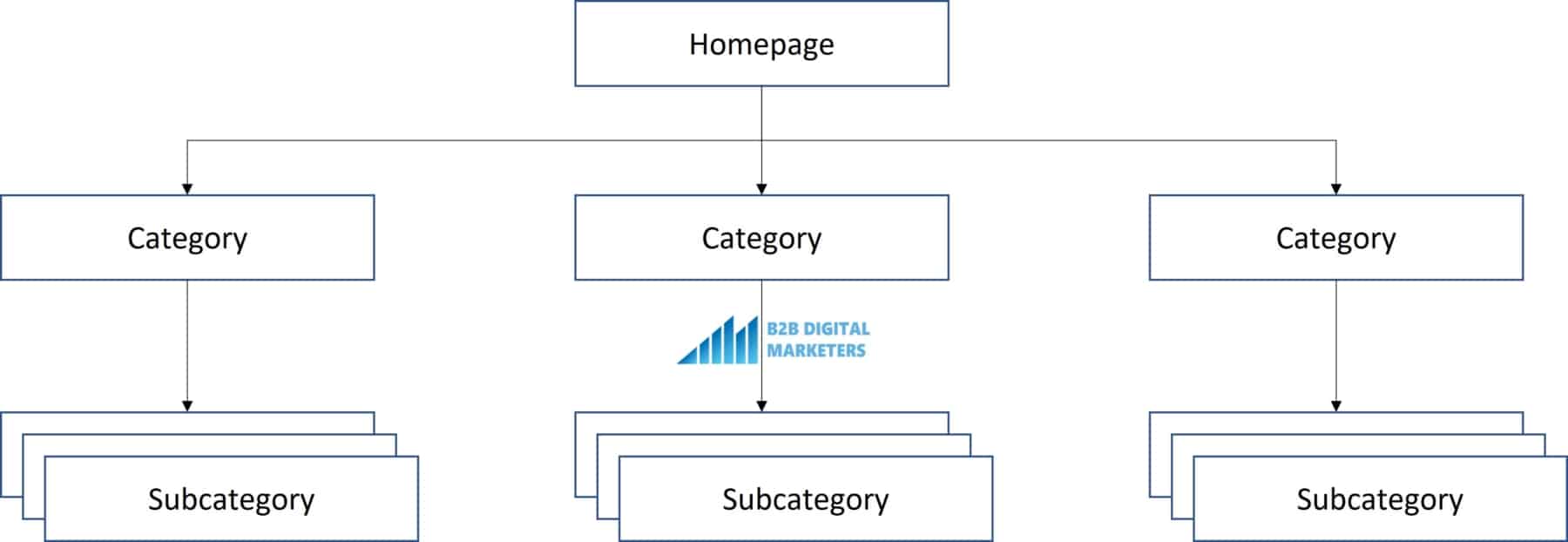
Arguably website structure is one of the most important SEO aspects, it helps users to navigate your website and find the right information they need which can boost user retention, time on a website, and conversion rates.
Also, properly optimized site architecture helps search engines to crawl and index your website faster as your content will be more accessible due to smaller crawl depth.
Thus, as a rule, your most important pages should have a crawl depth lower than 3 as any pages below 3 generally perform poorer in search engine results pages as search engines assume they are less important.
For example, in the SE Ranking Website audit, you can see some of my pages are in crawl depth 4 and deeper. This gives Google a signal that those pages are not as important to me.
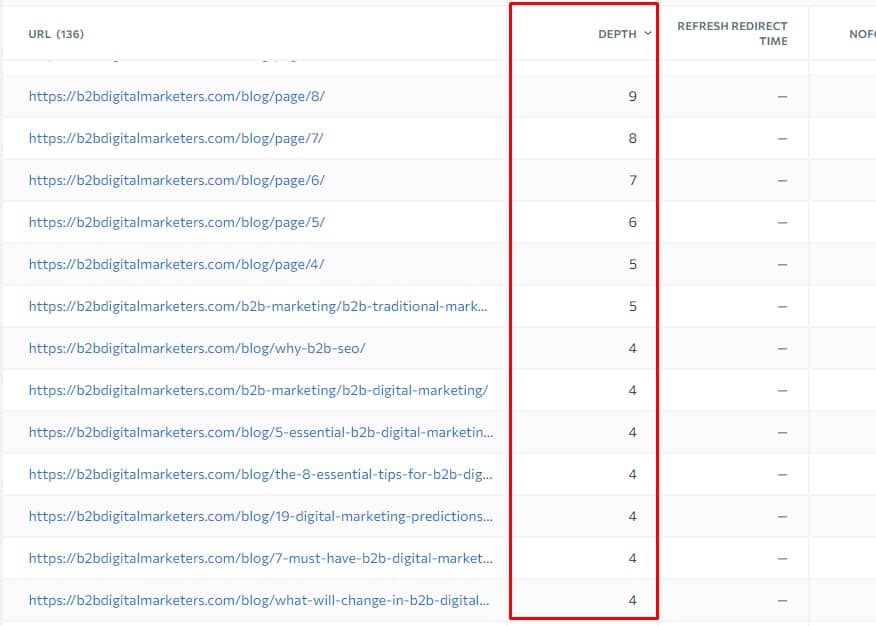
Therefore, here is an example of SEO-optimized website architecture that helps search engines to crawl the websites more efficiently and faster, without using too much crawl budget and you will get your most important pages rank higher.

As you can see the most important pages are reachable within 3 clicks from the homepage. This allows search engines to crawl your website effectively, understand the relationship between pages and your users can easily navigate your website.
Also, here is an example of a pillar page and its subtopics. The blue is the main content, the pillar page, where you create the really meaty 10,000 words ultimate guide type of content and then you create smaller subtopics to develop the topic.

And like this, you will create topic relevancy and strengthen your topic signals and help Google to index your website according to your targeted niche.
Internal Links
Another super important SEO part of the SEO checklist is to ensure your website is interconnected with internal links.
While Google is following sitemaps to discover new pages and recrawl other pages, most importantly Google is following your internal and external links to discover the internet.
Internal links are extremely important for your website and if strategically used you can improve the ranking of the most important pages on your website.
A method called the middleman from Ahrefs allows you to improve the ranking for your money pages such as product and service pages by creating linkable assets like blog posts that generate backlinks with them and then pass the valuable link juice to your money pages.

Let’s give an example, you have a page that generates a lot of high-quality backlinks. Thanks to that, it ranks high. So, to improve the ranking for other of your important web pages with fewer or no backlinks, you can use internal links which will pass the link juice. Thus, improve the ranking of the pages.
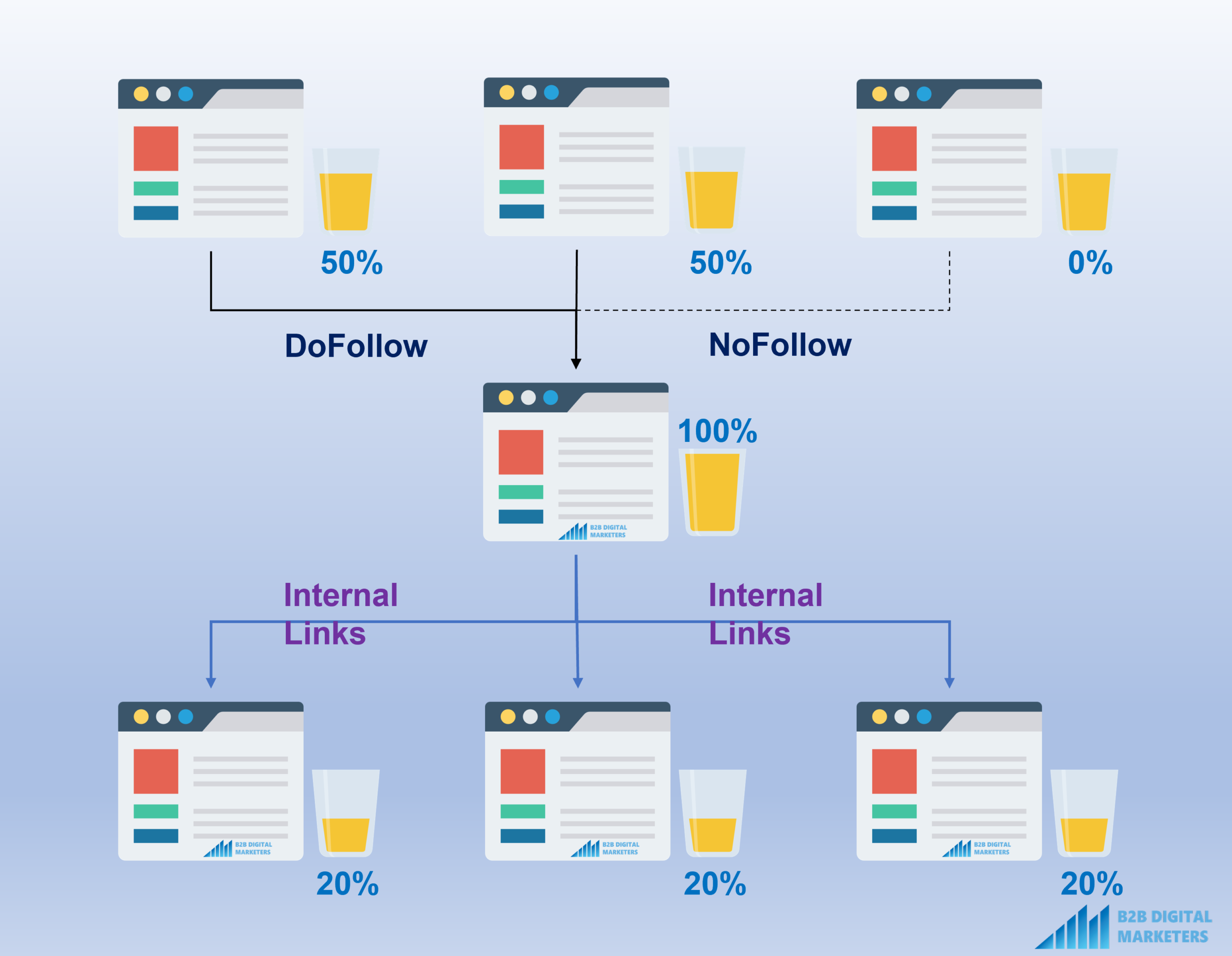
Also, a lot of high-quality backlinks you will generate via link building will be to your homepage. Therefore, having SEO optimized website structure in place and then connect all your important pages together with internal links will help you to boost your SEO which means a better ranking for your important pages.
For example, when we look at any website small and large, you will see their homepage has a lot of backlinks. Here are a few examples:
This one is my website.
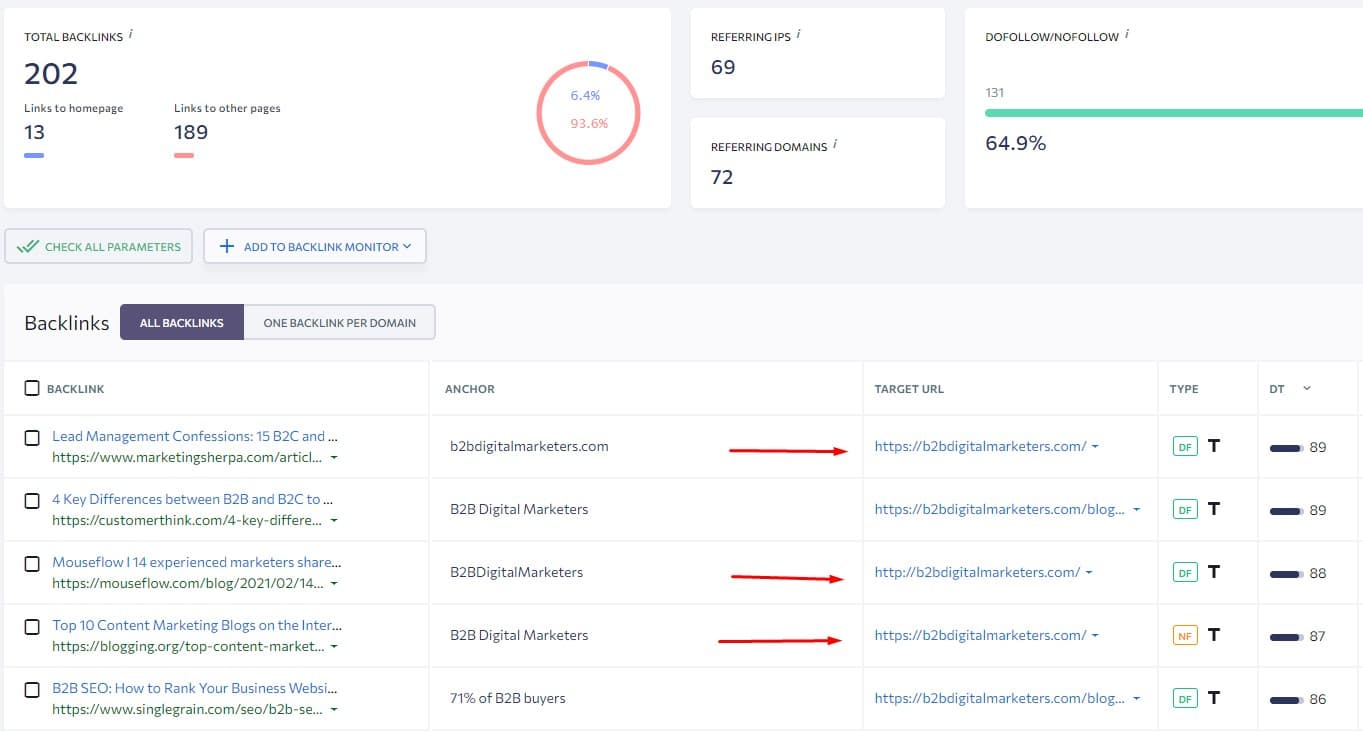
Here is an example of hellomarketingagency.com with a domain trust of 29.

And here is an example of a large site backlinko.com with a domain trust of 90.

As you can see your homepage will be generating a ton of backlinks. Therefore, you should give some thought to your website architecture and internal linking strategy.
Of course, there is more to crawling and improving user experience like making sure your website is responsive to all devices and sizes of screen and it loads fast on devices with slow internet speed.
However, these are the most important SEO aspects. Therefore, I included the above in this SEO checklist.
Step #3: Keyword Research
The third step of our SEO checklist is to do keyword research for your website.
Connecting keyword research with planning your website architecture and internal linking is super important and it is what separates real SEO pros from amateurs.
Starting strong from the beginning will drastically reduce the hustle in the future. Fixing internal linking, site architecture, and moving content around the website is a nightmare for every SEO professional, but it happened to most of us.
However, whether you already started or not, your keyword research will help you to fill up the content gaps, target the right keywords and establish your website as the go-to place for your targeted topics.
Also, before we start, I recommend you get a proper keyword research tool. if you do not have one, then you can use my favorite SE Ranking and get 14 days trial.
Like this, you can follow me along the way when completing your SEO checklists.
Also, this will not be a full tutorial on keyword research, If you want a full step-by-step tutorial on how to do keyword research then you can watch my video here:
Here I will shortly explain the most important parts of keyword research for the SEO checklist.
So without further due, let’s get started.
Seed Keywords/Pillar Page Keywords
The first important aspect of the SEO checklist for Keyword Research is to find seed keywords.
Seed keywords are the general topics, that you can further develop with more subtopics or subcategories to create topic relevance and increase topic signals so search engines can better index your website content.
And as you could already see on the website architecture, to have properly optimized website architecture you must start from the top which means finding seed keywords and then keywords ideas for subtopics and subcategories.
Here, you can see an example of SEO website architecture and how you should be targeting seed keywords, related and long-tail keywords, and branded keywords.
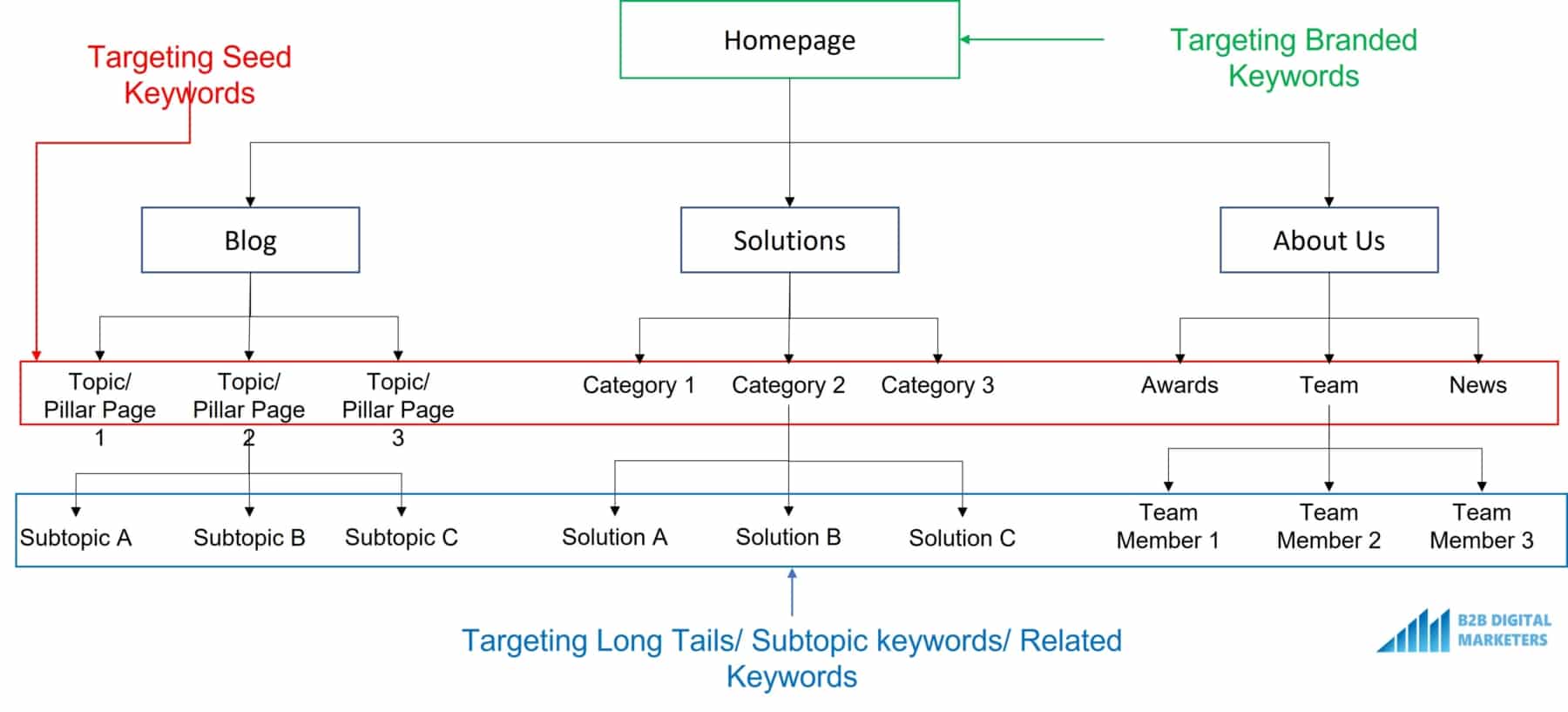
So, seed keywords are the main topic you want to own like for example SEO, Content Marketing, Email Marketing, or previous example electric cars.
So, if I want to target the topic “content marketing”, then this will be my seed keyword and I will need to find keyword ideas for subtopics like “content marketing tips”, “strategies”, or “tools” to name a few.
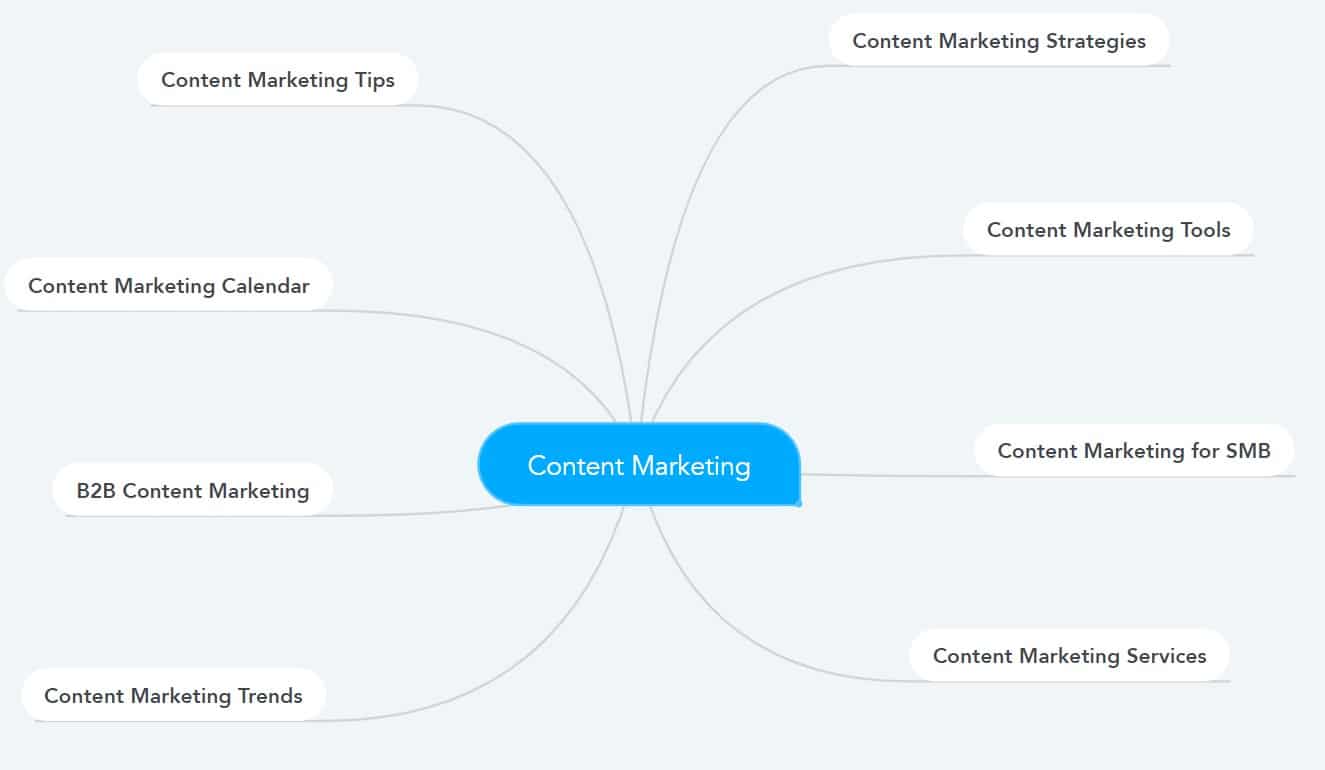
With that, let me show you my favorite technique to find tons of great seed keyword ideas.
First, I pop my website into the SE Ranking Competitive Research tool. However, if you do not have any content on your website, then I recommend you find a close competitor with the same content you want to target, but in my case, I can put my website.
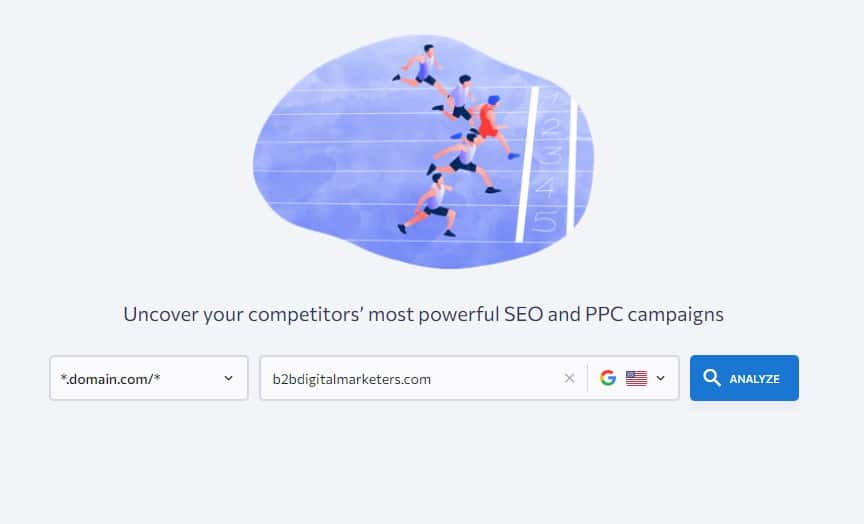
Then I will go to the “Competitors” report to get a list of my competitors.

And here I will pick competitors that are:
- At the same level as me, which means domains with domain trust between 10-30.
- High-level competitors that target topics I want to target as well in near future.
However, let me just show you one example. For example, let’s have a look at webfx.com by clicking on the domain name. This will open up the competitor report for the selected competitor webfx.com.
Now I will open up the keywords report by clicking on the number of keywords.
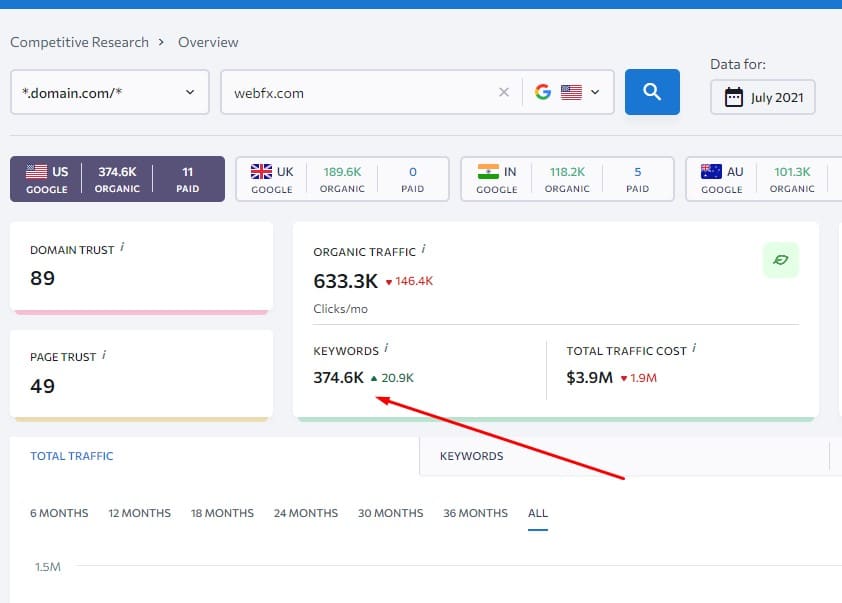
And here I have a list of all keywords my competitors are ranking for along with additional helpful information. Especially I like to see the SERP features because it helps with targeting.
For example, the keyword “social media management” has YouTube, Featured snippets, and Podcast SERP features, which means I can target the keyword with my blog post, videos and if I would have podcasts I could target the keyword as well. Really love this feature in SE Ranking and super helpful!
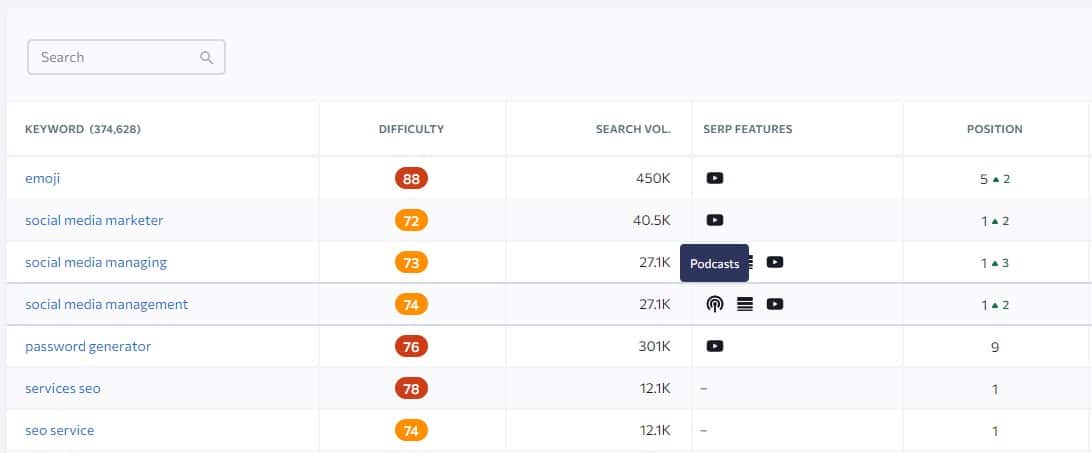
Anyway, now to find seed keywords I will simply scan the list and try to find any generic keywords that are related to me and right away I can see keywords like “youtube studio” or “google search console”.
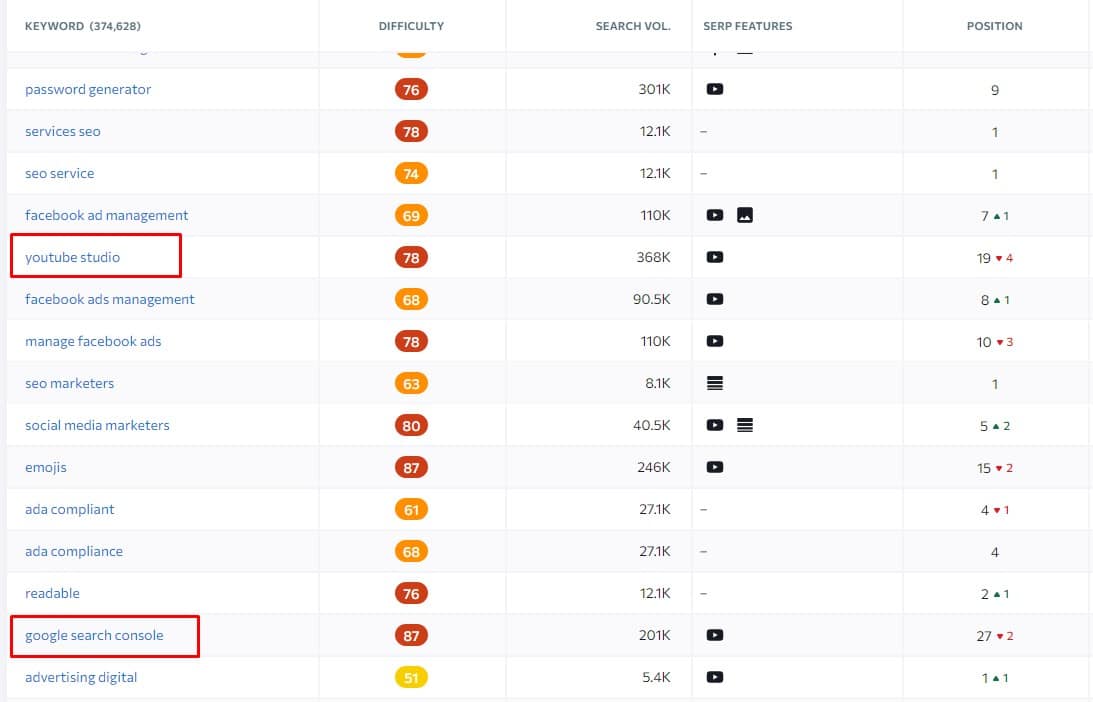
Both these keywords are super relevant to me and I have experience in both using these tools and had had some success with them. Therefore, these could be definitely interesting seed keywords.
However, you can make a seed keyword pretty much from any keyword you are seeing, you just need to make it more generic. Like the keyword “SEO marketers” where the seed keyword would be “SEO” or the keyword “social media marketers” where the seed keyword would be “social media” or more related to me “social media marketing”.
Alright, so let’s pick “google search console” as the seed keyword. But I recommend you find at least 10 seed keywords, but as I said, this is not an article on keyword research.
Keyword Ideas/ Subtopics
The next on our checklist is to generate keyword ideas or subtopics for your seed keyword or pillar page.
This is important because if you want to own a topic, you must create as much content around the topic to send a strong signal to Google that you are the expert in this topic and you have a lot of value to share with your audience.
Therefore, finding a topic or seed keyword is essential for generating keyword ideas.
With that to find keyword ideas or subtopics to your seed keyword is pretty much straightforward.
I will use SE Ranking keyword research tool to do that. Here I enter my seed keyword “google search console”, select my targeted location, and hit analyze.
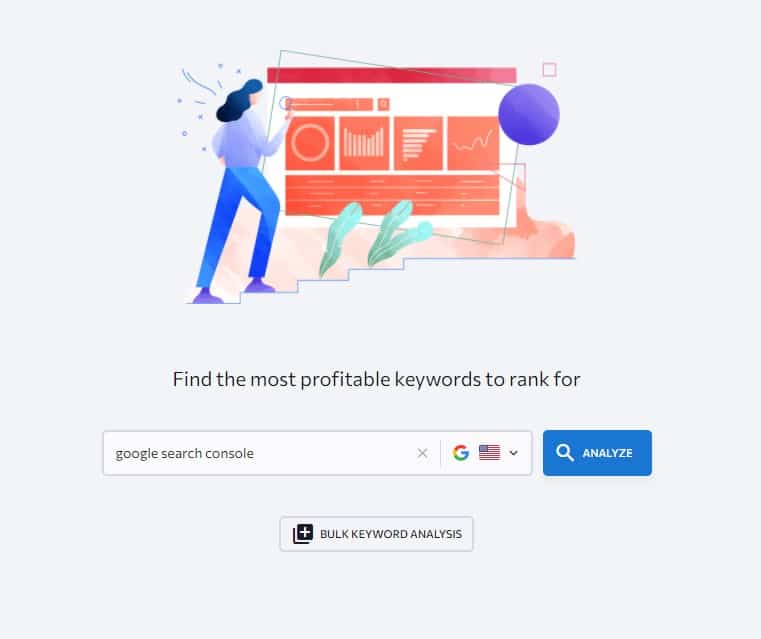
And here I will get more information about the keyword such as the keyword difficulty, monthly search volume, CPC, and keyword ideas.
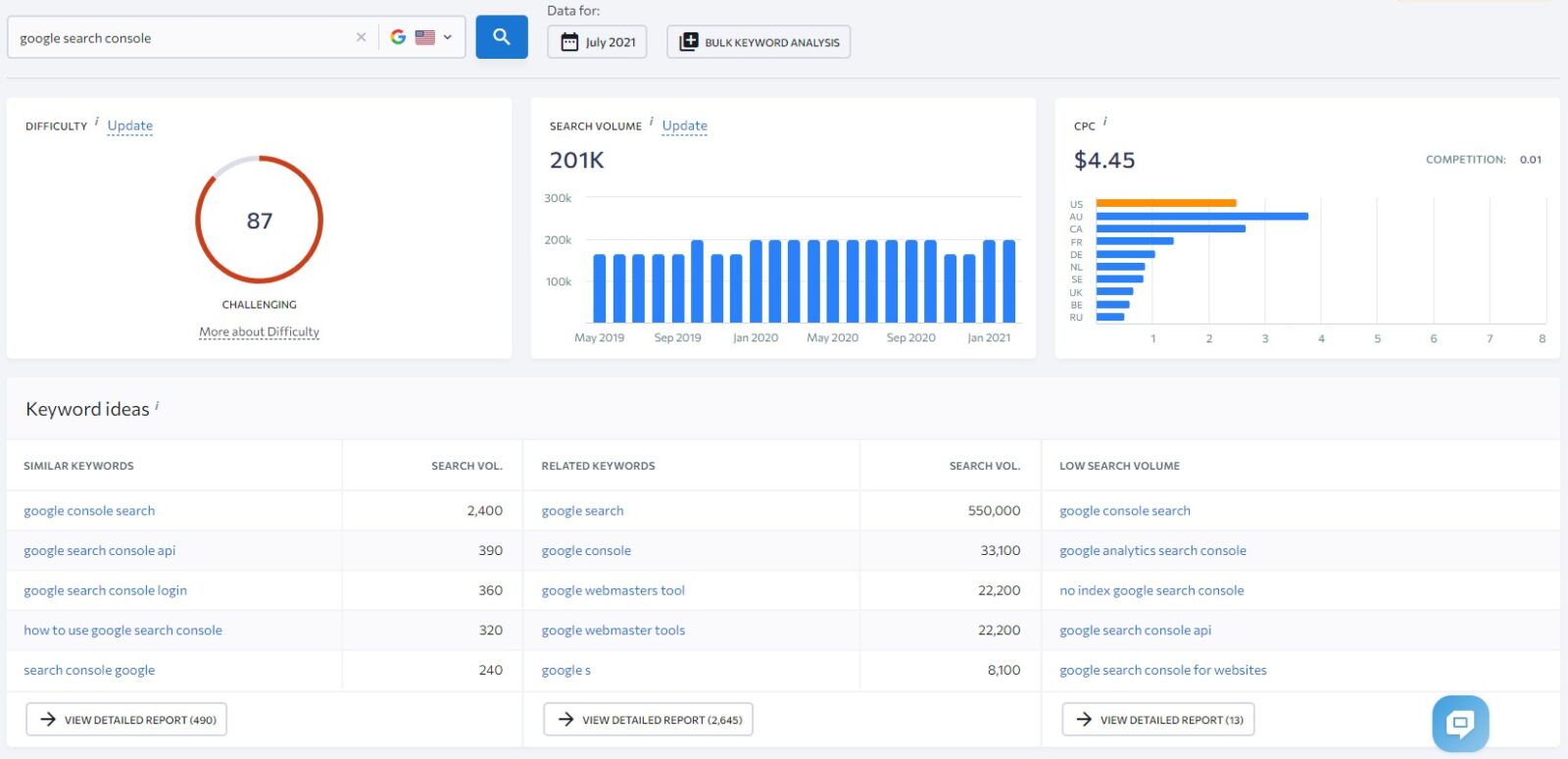
Now I can open the “Similar Keywords” or “Related Keywords” report. I can start with either way as I recommend check both for keyword ideas and I can easily switch between the reports.
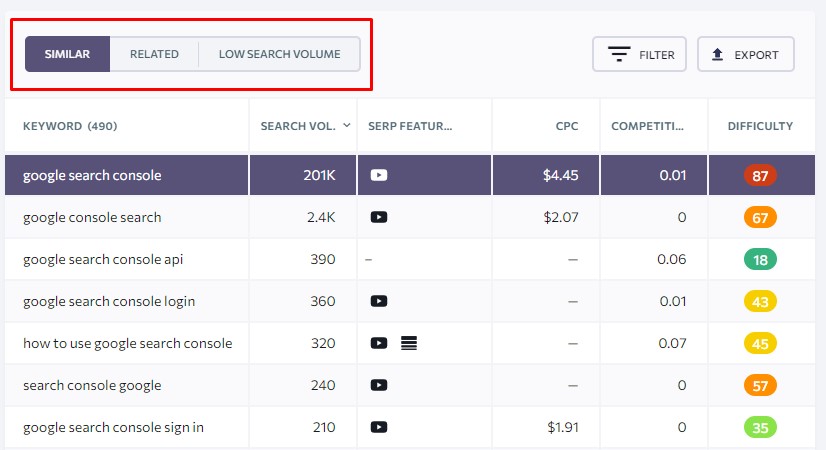
Alright, now I can start scanning the keyword to find any keywords ideas for my topic “Google Search Console”. Also, depending on the seed keyword you might want to add some filters.
And after a while of scanning keywords, I have created my topic cluster. Here you can see an example of a topic cluster or my topic and its subtopics using a mindmap.

This tool is helpful to visualize your topic clusters and if you have ever used HubSpot CMS they also included a mind map for creating topic clusters.
And now, I am ready and can start creating content around the topic.
LSI Keywords
The next on our SEO Checklist for keyword research are LSI Keywords.
LSI Keywords are related keywords to a targeted keyword that search engines associate together. These keywords help search engines to better understand what is your content about. Therefore it is recommended to sprinkle LSI keywords in your content.
LSI keywords are great to improve your content targeting, answer searcher questions and provide depth to your content to make it more comprehensive. It increases the chance to rank for more related keywords, thus, increase organic traffic generated from the piece of content.
And if you want to learn more about LSI keywords you can watch my video here:
So, let’s give an example.
Let’s say, I am going to create a piece of content to target the keyword “SEO strategies”.
So, one of the techniques to find LSI keywords you can use is a keyword research tool and enter your targeted keyword.

Now, I will open up the “Similar Keyword” report to get keyword ideas closely related to my keyword “SEO strategies” and again will scan the list for any keywords that make sense to be included within my content.
And for example, keywords like “best SEO strategies”, “SEO content strategy”, “b2b SEO strategy”, and “mobile SEO strategy” are great keywords that I can blend within my text to improve my organic traffic and ranking.
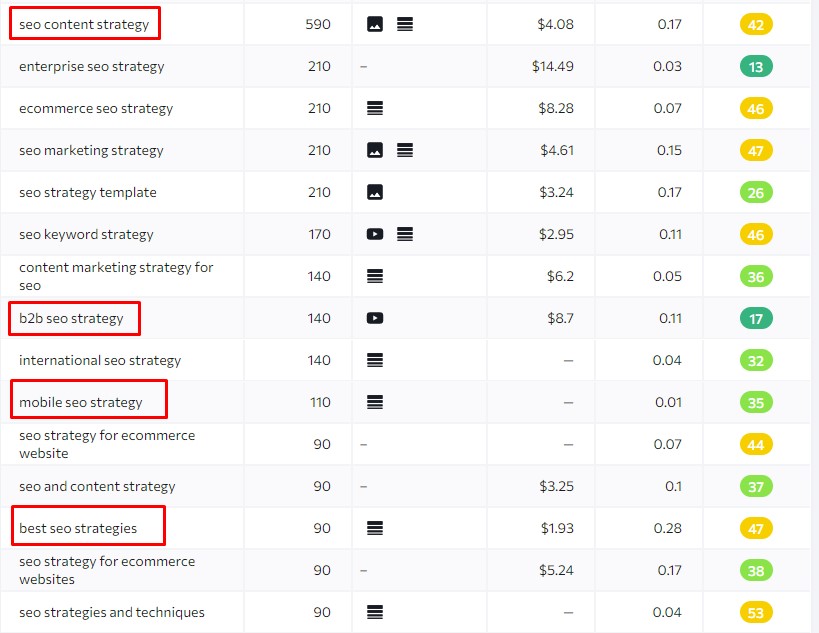
And this is just an example, but I hope you got the idea.
Content Gap Analysis
The last part of the SEO checklist for keyword research is to perform a content gap analysis.
Content Gap Analysis means the process of searching for related content that your competitors are having on their website that you do not have. Then discover missing opportunities and gaps that could be improved within the content and lastly publish a better version of the content to target the missing keyword.
This means analyzing the search intent, information, media, and basically anything that you believe is missing within the piece of content and then making your content more comprehensive.
And if that’s sounds familiar to you, then you are right. The skyscraper technique is all about content gap analysis. Only you are searching for content gaps with a lot of backlinks and then improve on that content or as Brian said:
“Find the tallest skyscraper in the town, build your own and slam extra twenty floors on it”
Anyway, let me show you how you can find a content gap for your website.
First, fire up your SEO tool. I don’t know which tool you are using, so let me show you SE Ranking, but most SEO tools have a similar feature to the one I am going to show you.
So, I open SE Ranking Competitive Research tool and enter my domain and select my targeted location, and hit analyze to find a suitable competitor.
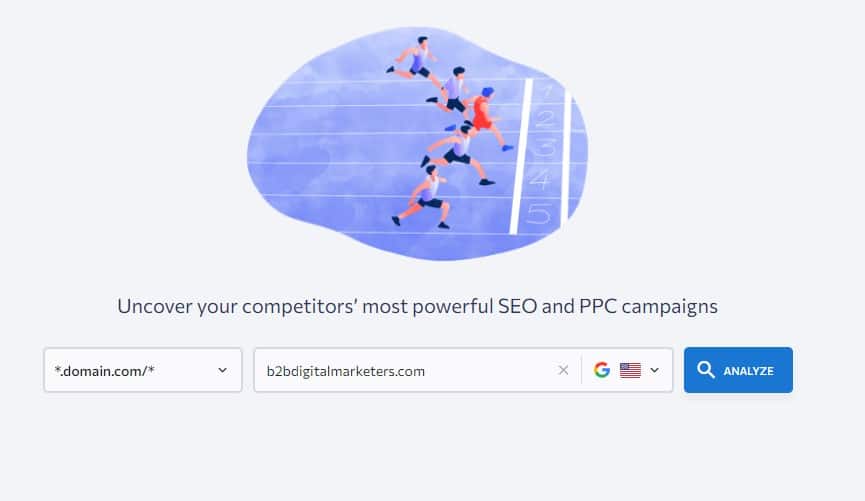
Then I open up the “competitors” report and start searching for competitors that are not as high as me which means competitors with domain trust not higher than 50. The reason why is because I want to find content that my similar-level competitors are targeting, and it drives them traffic.
And one of the examples could be ninjareports.com. They have DT within the range I set and their organic traffic is not bad and most importantly they are ranking for over 7,000 keywords that I am missing. Therefore let’s pick them as an example.
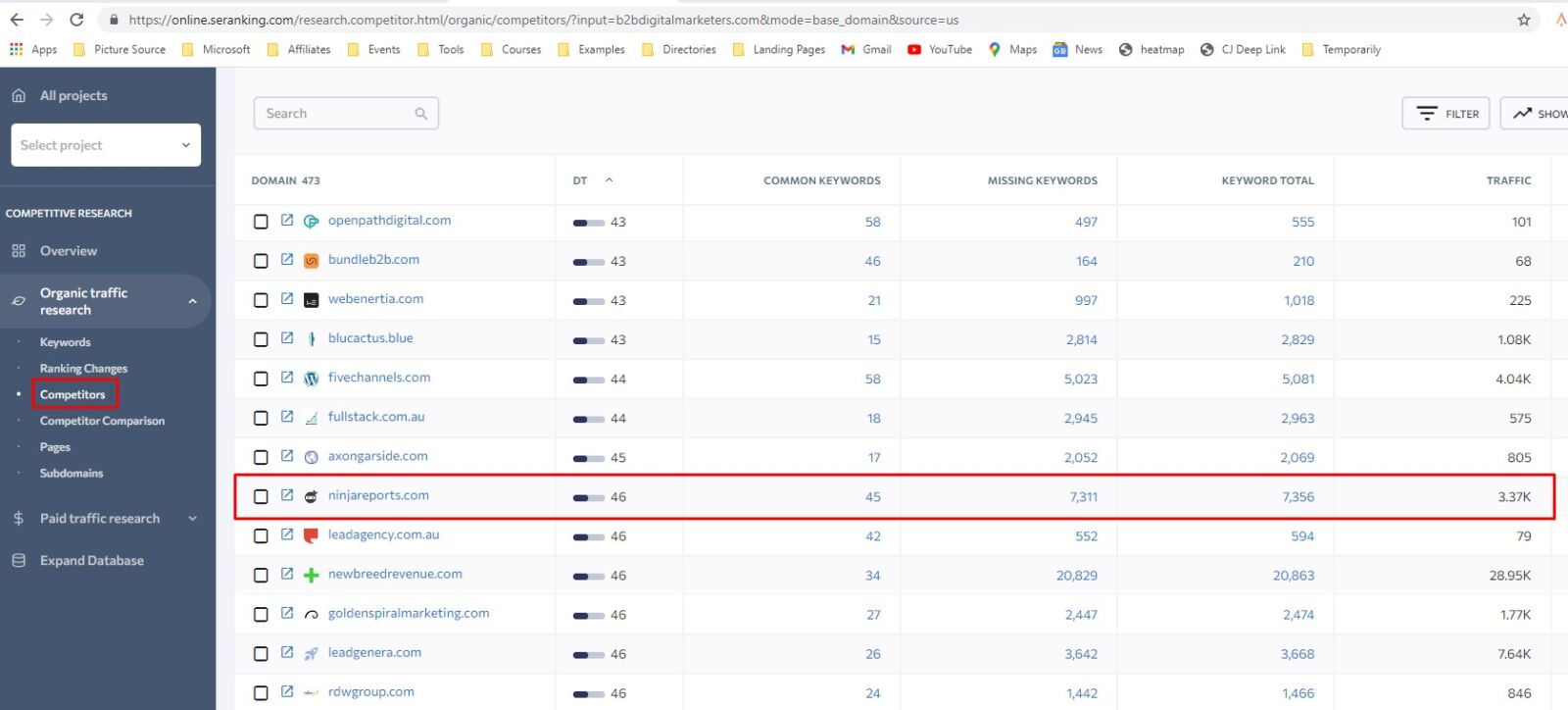
So, once I have my competitor, then I simply click on the number within the column “Missing Keywords” which will direct me to competitor comparison.

And here you will get all the information you need to find missing keywords for your website. However, what I like to do is to change to the “Unique Keywords” tab and select my competitor’s website.
And what it does, it shows me all the unique keywords the selected website is ranking for but the other not, and also it gives me their precise ranking position.
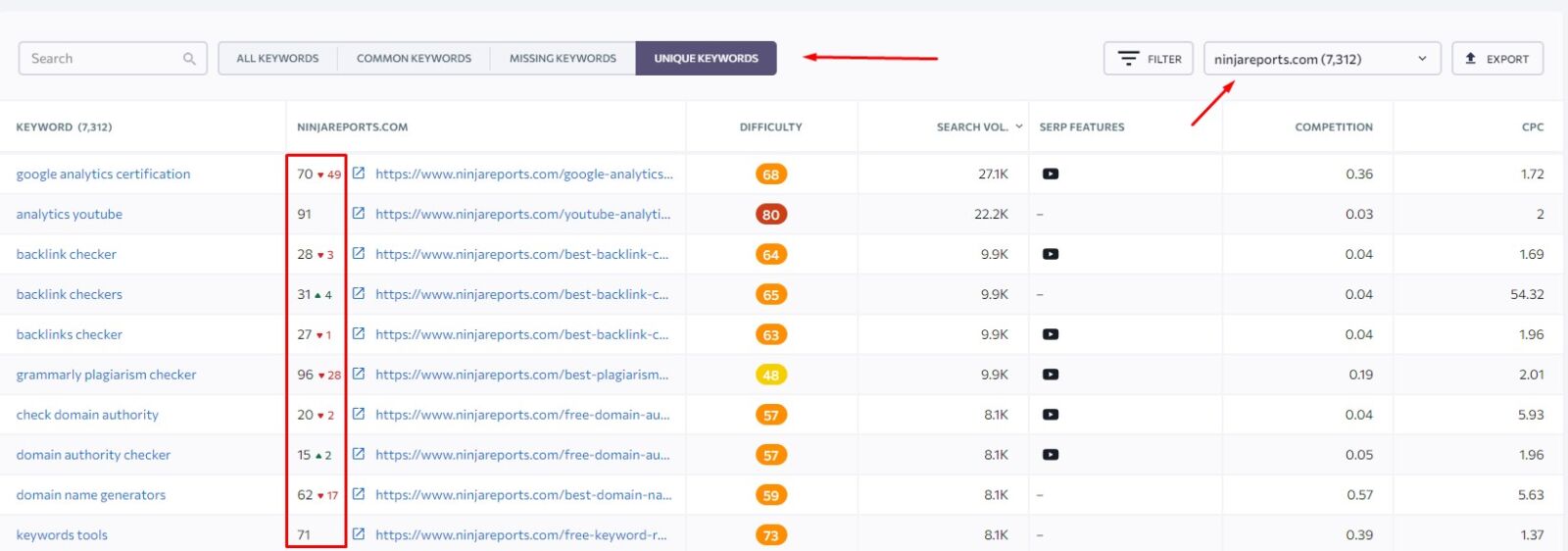
And this is super helpful to me because now I know if my competitor with twice higher domain trust cannot rank for the keyword in the top 10, then I definitely don’t have a chance.
However on the other side, if they rank in the top 5 or even 10, then I have a chance to rank in that positions as well by using a few linking building strategies.
So, that is everything I have for you for the SEO checklist for keyword research.
Step #4: On-Page SEO
The next important step within your SEO checklist is your on-page SEO and how well it is set up.
On-Page SEO plays a vital role in your SEO and it addresses every aspect of your website to ensure you are delivering optimize user experience (UX) and search engines can better understand what is your content about.
And if you want to learn everything about on-page SEO, best practices, and how to implement it for your website you can watch my video here:
However, in this SEO checklist, let me share with you the most important on-page SEO strategies and techniques you should always implement for every of your web page.
Technique #1: Keyword Placement
The first technique on our SEO checklist is keyword placement.
Keyword placement means including your targeted and LSI keywords within certain aspects on your page to improve your targeting and ranking for the keyword and to give Google a strong signal of what is your web page about.
Including your keyword is probably the most important on-page SEO strategy that every SEO will recommend you start with. Otherwise, how can Google tell what is your website about?
Thus, here is a keyword placement infographic to help you where you should include your targeted and LSI keywords.

So, include your keywords within:
- Your URL and keep your URL short and sweet.
- H1 & H2 headers
- Title tags and meta description
- Within the content
- Picture’s name and alt-tag
- And within internal links from other pages
Also checkout my guide on keyword placement in WordPress.
Technique #2: Keyword Density
The second on-page SEO strategy on the SEO checklist is keyword density
Keyword density means how often you are using the keyword within the page itself and not for an entire website.
Google is still using keyword density, but slowly moving from it as their algorithms can now detect related words and understand the meaning of sentences.
However. In many cases, when SEO newbies learn they should include targeted keywords within their content, they will go overboard and start putting keywords everywhere and whenever it is humanly possible.
However, this is called keyword stuffing and it is also against Google Quality Guidelines.
Therefore, I recommend you to have keyword density between 0.5% to 1% for the main targeted keyword. This means if you have 1,000 words article, then you should use the keyword between 5-10 times just for search engines to understand what is your content about.
And for LSI keywords it is often enough to mention it once or twice, depending on the importance of the keyword.
I also recommend you to first write your piece of content without worrying about the keywords and then optimize your content for the targeted and LSI keywords.
And lastly, if you have installed an SEO plugin like Rank Math, then they actually track the keyword density for you along with other on-page SEO aspects as mentioned.
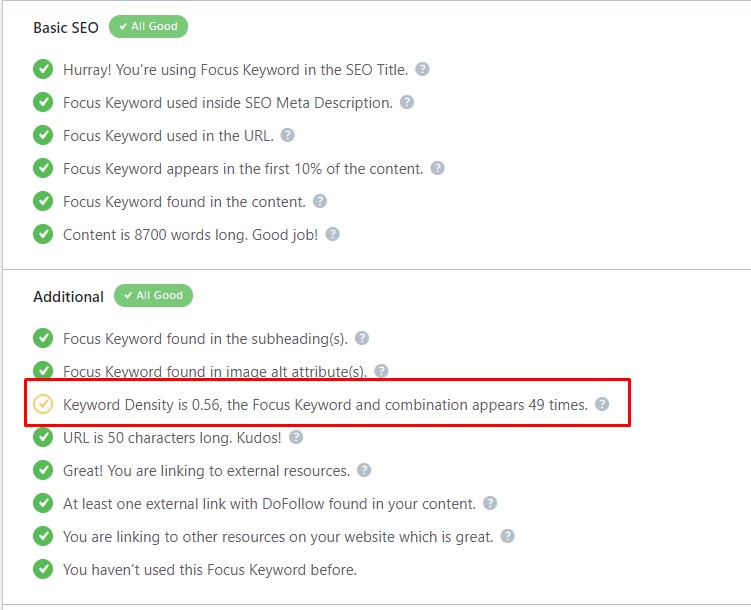
Technique #3: SEO Optimized Images
The next important technique I want to mention in the SEO checklist for On-Page SEO is SEO-optimized images.
Whenever you can, you should always be using images within your content regardless it is a blog post, product, or category page.
Images make your text more engaging, eye-catching, and, in many cases, you can better explain something using one picture than writing an entire paragraph.
For example, if you look at this article, you will find over 50 images and all of the SEO optimized. But what is it mean?
So, to have your images SEO optimized you should follow these best SEO image practices:
- Use lazy load for your images, which means the picture only loads as you scroll.
- Include keywords in your image name and alt tag. Not in every picture though, just a few times is enough.
- Compress your images and add responsiveness. You can use SEO plugins like ShortPixel or others.
- Use also caching plugin to help you with images such as WP Rocket.
- And lastly use SEO-friendly images formats like PNG, JPG, or Webp.
Technique #4: Schema Markups
Another important On-Page SEO technique on our SEO checklist is schema markups.
Schema markup is a code specifically designed for search engines to read and get extra information so they can display it within the search engine results pages.
And there are several different schema markups such as
- Recepi schema markup

- Featured Snippet Markup

- Product schema markup
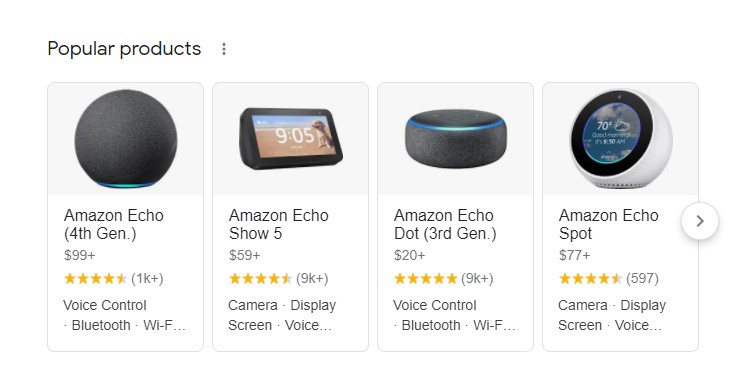
And many, many more schema markup.
All these schema markups help your website to rank better for all kinds of content and improve your click-through rate.
With that, I recommend you to include at least these schema markups for your website wherever applicable:
- Article schema markup
- Breadcrumb schema markup
- Product or service schema markup
- FAQ schema markup
- Event schema markup
Furthermore, I recommend you to use a plugin to install schema markup on each individual web page if you are not a web developer. For example, Rank Math helps you easily select and install schema markup for every individual web page.
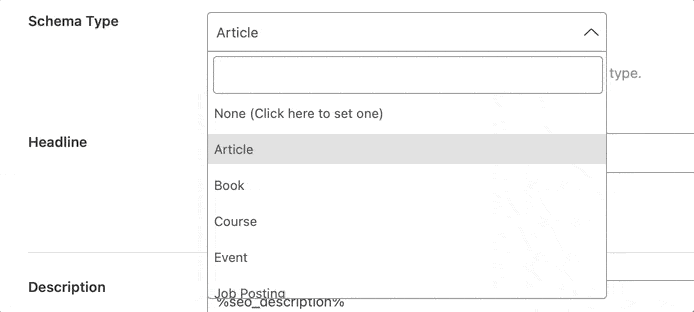
Additionally, you can check if the plugin installed the selected schema markup properly by using Google Rich Results Test.

Technique #5: Competitor On-Page SEO
And the last on-page SEO technique I want to mention in this SEO checklist is to analyze your competitor’s on-page SEO.
Nowadays, if you want to rank for more competitive keywords you need to go above and beyond and every little improvement on your web page can mean outranking your competitors which can mean a huge difference in organic traffic.
A study by Backlinko on organic click-through rate shows that position #1 in Google gets on average 31.73% of all clicks and position #2 gets 24.71%.
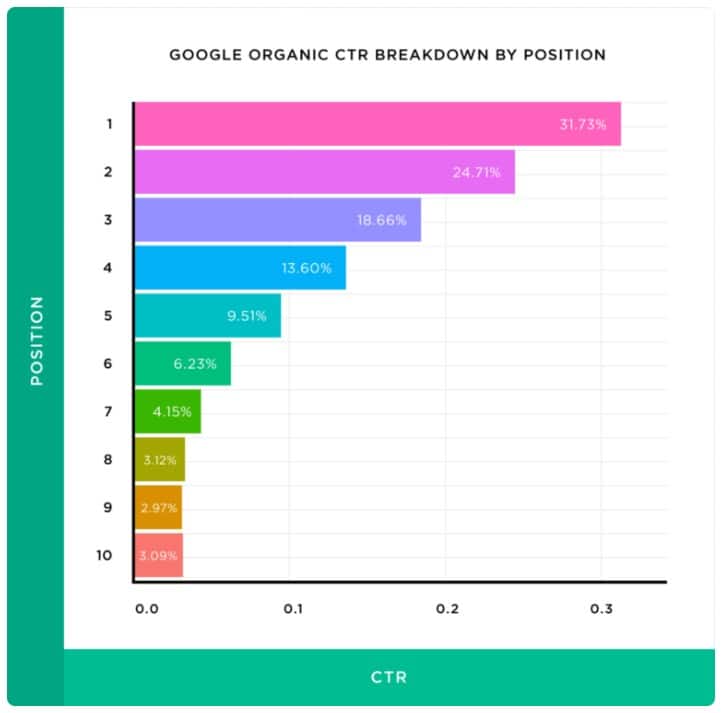
For example, keywords with 100,000 monthly search volume can generate over 31 thousand organic traffic for web page ranking #1 and 24k organic traffic for web page ranking #2 which is a 7 thousand difference in organic traffic.
So, imagine keywords with a 1,000,000 monthly search volume.
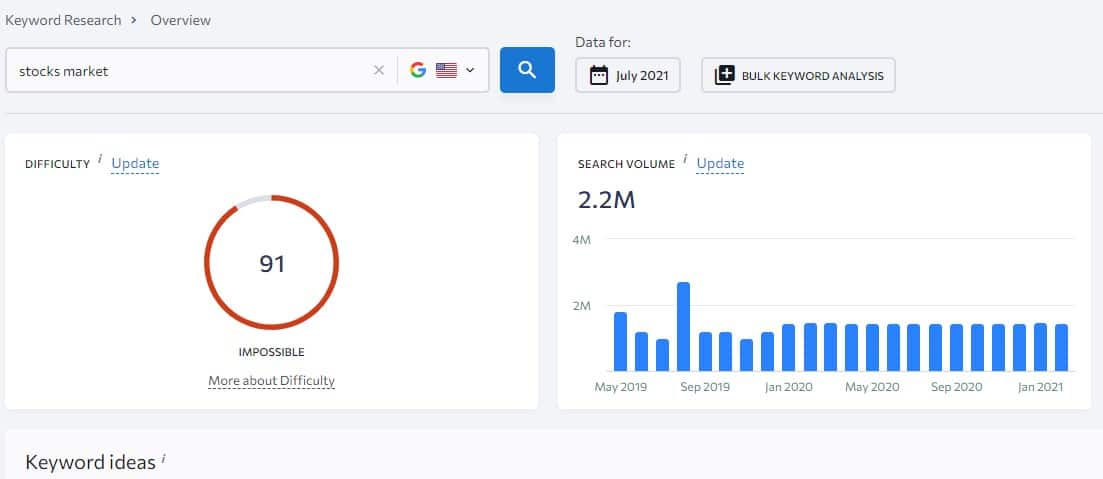
Therefore, analyzing your competitor’s web page that ranks for your targeted keyword helps you to find weaknesses and gaps that you can improve on.
With that let me show you how you can analyze your competitor’s web page on-page SEO.
To do that I will use SE Ranking On-Page SEO checker and good old fashion Google.
First, I need to get the top 3 or top 5 ranking pages for my targeted keyword. Let’s say I am targeting the keyword “on-page SEO”.
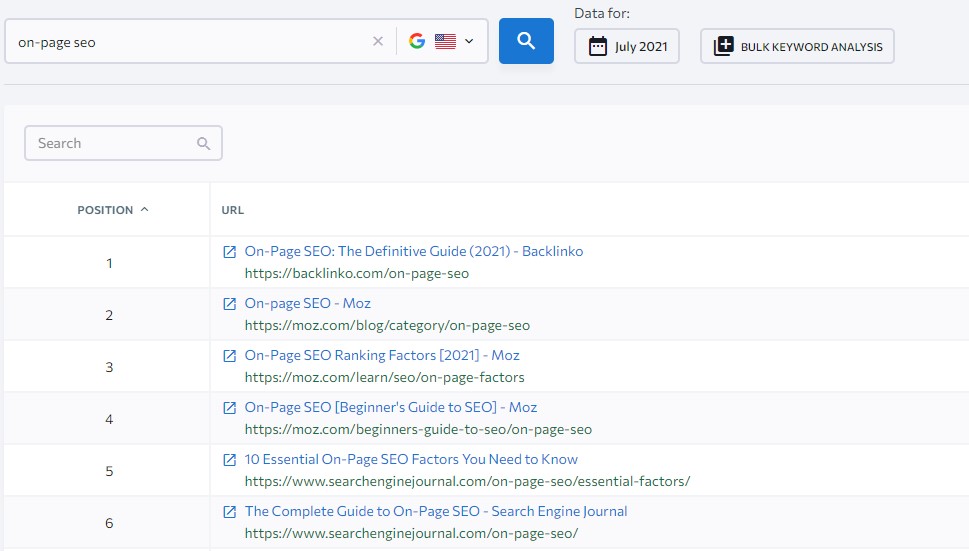
Once, I have the list of top-ranking pages, then I open all of them in the browser and copy-paste the URLs into SE Ranking On-Page SEO Checker. However, for this tutorial, I’ll do it only for the first ranking page to cut it short.
Then I’ll take the URL and paste it into the SE Ranking On-Page SEO Checker, enter the targeted keyword or ranking keyword of the page and let run the audit. Check out how to do full SEO audit and B2B SEO audit.

And while the on-page SEO checker audit is in progress I will go through the competitor website and look for anything that might be wrong. Typically, I am looking out for things like:
- Published date or update date.
- Not using any media like pictures, videos, or graphics or very little.
- Using old data and statistics.
- Bad content formatting like long paraphs without spaces.
- Not using headers.
- Missing information on the topic.
- Or generally, it feels outdated or poor quality content
And based on this I will take notes for myself and then improve that within my content.
Also, once the on-page SEO checker is completed it gives me in-depth look at how well the page is optimized for the keyword, user experience, off-page SEO, and other ranking signals.
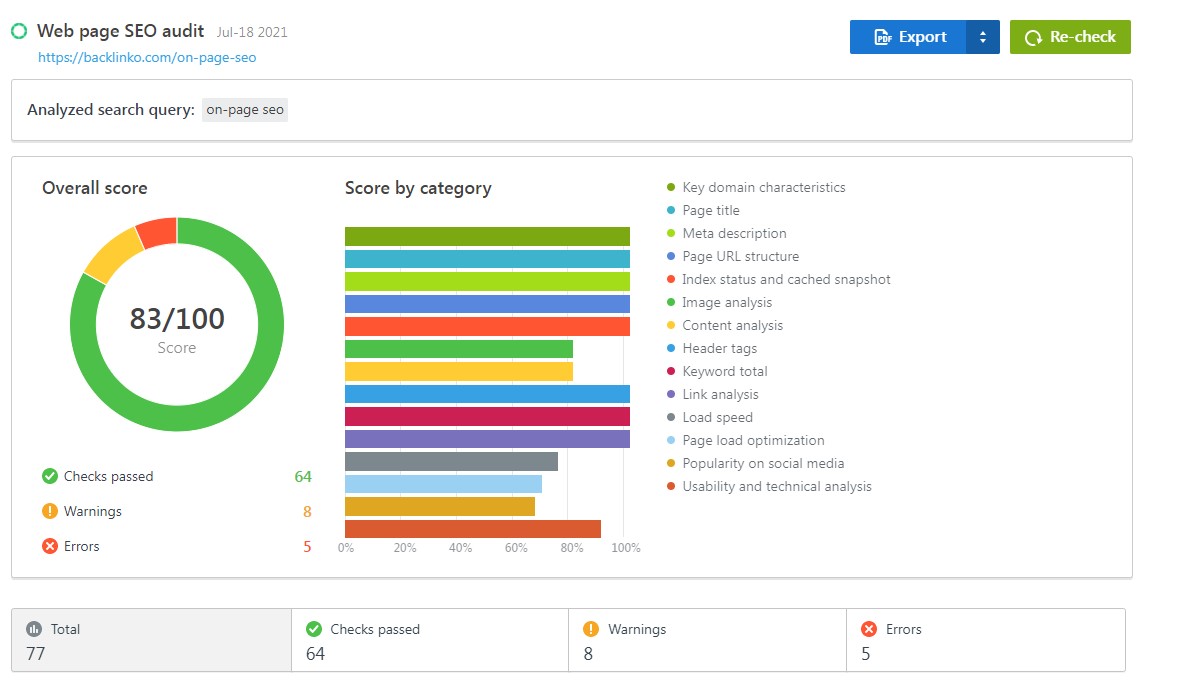
Obviously, Brian did a great job with his on-page SEO guide so I will not try to find any SEO mistakes or things I could improve on as it would be very hard.
And that’s everything I have for you for the SEO checklist for on-page SEO and let’s move to the next step.
Step #5: Off-Page SEO
The next step is arguably the most difficult and by many, the least favorite and that is off-page SEO.
Off-Page SEO is not only about link building and there are many more things you can do to improve your off-page SEO without actually building backlinks.
However, although link-building strategies are not all there is to off-page SEO, and I would love to tell you that creating great quality content is all that you need.
Unfortunately, if you want to rank in competitive niches or for competitive keywords, then you will need to do link building at some point.
However, as I said, it is not the only thing you can do to improve your Off-Page SEO and ranking and if you want to learn more about it, then you can watch my Off-Page SEO guide here:
However, in this SEO checklist, let me share with you the most important off-page SEO factors you should try to implement for your website. Also, check out our handy On-Page SEO vs Off-Page SEO Infographic.
Factor #1: E-A-T
The first and arguably one of the most important off-page SEO factors that you must establish is Google E-A-T which stands for expertise, authority, and trust.

Regardless of the nature of your business earning the trust of your customers is definitely the most important part of doing business and that same applies to Google as well.
They want to know if they can trust that you can deliver high-quality content with a satisfying amount of information in your niches.
Therefore, focusing on improving your online credibility will help you to rank better. And to improve your website E-A-T there are several things you can do:
- Create an “About Us” page and show that behind the company or website are real people with real passion and not scammers.
- Include official and personal/professional social media accounts like Twitter or LinkedIn to help people learn more about the creators.
- Have an author’s page on your website to showcase the credibility of the written content on your website.
- Have high-quality content on your website that seems to be valued by many. Also, make sure you regularly update your content.
- Have a topical focus. Creating content about everything means creating content about nothing.
- Become a guest contributor on podcasts or publishing guest articles.
- Become more social and create social media for your brand and grow it.
Showing users and your customers that your website and/or business is run by professionals not only helps your visitors to trust you but also Google can collect certain signals to determine if you are trustable or not.
Factor #2: Brand Searches
The second important off-page SEO factor is brand searches.
Brand searches or branded keywords show the popularity of your brand and the more people are searching for your brand the more Google will pay attention to you.
Unfortunately, many SEOs are only focusing on keywords with search traffic, but they do not realize how important is to create their own branded keywords for SEO.
Therefore, creating and optimizing for branded keywords will be one of the best SEO hacks you can implement for your website.
However, how can you create a brand search?
Well, there is a number of different ways to achieve that, but as the name suggested, you need to first create a brand, whether personal or professional and then create brand awareness.
A great way to actually get brand searches is to create YouTube Channel. YouTube works more like a suggestion engine and many people will discover you there and then search for your brand after watching your video.
Then I also recommend becoming a contributor on different platforms and become a guest speaker or blogger on another website. Creating brand awareness outside of your website will help you to increase brand searches.
Factor #3: Backlinks
Another important off-page SEO factor is backlinks or link building.
Like I said, if you want to rank for more competitive keywords and/or speed up the process of getting high organic traffic, then you will need to do link building as link building benefits are enourmous.
And when it comes to link building strategies there are many different ways to build links to your website and I have published a video about easy link building strategies for beginners that you can watch here:
However, before you start any link building I recommend you to do Competitor Backlink Analysis to discover how your competitors are getting backlinks. And luckily I have a step-by-step tutorial to help you with that which you can watch right here:
Factor #4: Customer Reviews
And the last off-page SEO factor I want to mention is Customer Reviews.
Customer reviews have been important to users for a really long time and 87% of consumers read online reviews for local businesses – up from 81% . So, it would be foolish to think Google will not use those to determine your ranking.
In fact, according to Moz.com, review signals make up about 6.47% of Google Ranking factors how they determine your ranking.
Therefore, actively collecting reviews for your brand whether you are local or global will help you to boost your SEO results as it is an important off-page ranking factor and whenever you can you should collect those! To learn more check out my off-page SEO activity list with over 50+ strategies.
Final Words
As you can see, SEO has many aspects that come into play when search engines are assessing your ranking. However, as you will get familiar with SEO you will find out that the things that make a real difference are not as hard apart from link building.
Otherwise, the rest is pretty standard. Remember, if you want to improve your ranking, just focus on your customers or users, and try to provide the most value you can.
If you are creating content, make it easy to understand that even absolute beginners can apply your tips right away without struggling. Making it easy is always a good way to go.
However, if you have more questions, feel free to contact me and I will do my best to answer them in my blog posts or you personally!
Related Articles:
- How to Write SEO Content: Learn How to Rank #1 in Google
- B2B SEO Strategy: 8 Steps to Effectively Generate Leads and Organic Traffic
- Core Web Vitals: What They Are and How to Improve Them (Improve Ranking)
- How to Do a Content Audit for a Website?
- Most Important SEO Techniques to Drive Traffic & Leads
- How to Find profitable Keywords for Your Website?
- 101+ B2B SEO Statistics You Should Know
- White Hat SEO: Best Techniques & Tactics in Step-by-Step Guide
- SEO Strategy: How to Start with SEO
Also, check out our SEO hub page to find all our SEO resources.
Disclaimer
Some pictures are coming from Freepik and some of my links are affiliate links, which means if you purchase something, I might get some small commission as a reward for reference. Of course, I am actively using all these services and products, and I only affiliate products or services I have full trust in their quality!
Support the B2BDigitalMarketers
Hey, Eduard here.
As a solo blogger with limited resources, I need your support to keep creating in-depth SEO content like this. Please consider joining my Patreon community to help this site grow.
Your pledge – no matter how small – will enable me to dedicate more time to sharing actionable tips and strategies. With your help, I can take this project to the next level and really make a difference for other SEOs and marketers.
I would sincerely appreciate you joining me on this journey as a founding patron. Together, we can build an amazing resource hub. Hope to see you on the inside – thanks for your trust and support!








